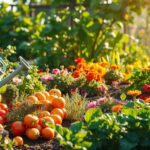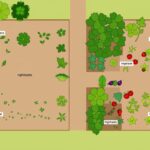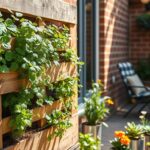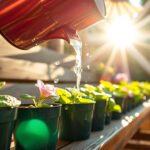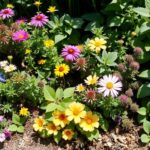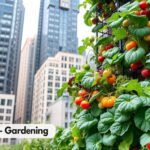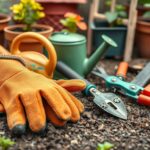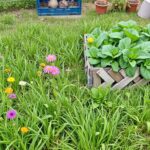Uncategorized
10 Must-Have Blooms for Your 2025 Garden
Get ready to refresh your garden game with the hottest flower trends for 2025! This guide breaks down the top 10 must-have blooms that will transform your outdoor space into a colorful paradise. From unique varieties to eye-catching pairings, these floral picks are perfect for every gardener looking to add a touch of beauty and flair to their landscape.
Get Ready To Transform Your Garden!

The new year is here, and with it comes a wave of exciting garden trends! If you love flowers and want to keep your garden looking fresh and stylish, you’re in the right place. Gardeners and experts have spoken, and we’ve rounded up the top 10 flower trends that will be blooming in gardens everywhere this year. Let’s dive in!
1. Soft, Earthy Colors Are Taking Over
In 2025, gardens will be all about soft, earthy colors that create a calm vibe.
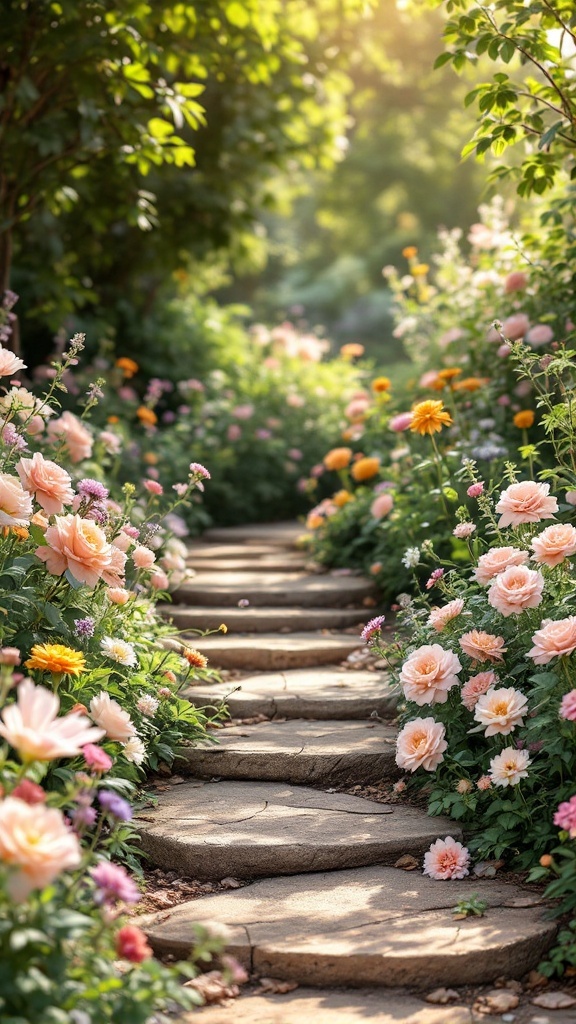
Think gentle pinks, warm yellows, and soothing greens that blend beautifully together. These colors not only brighten up your space but also invite a sense of peace and tranquility into your outdoor area. Flowers aren’t just about bright and bold anymore. This year, muted tones like dusty pink, lavender, peach, and soft white are in! These calming colors bring a sense of peace and pair beautifully with classic cottage-style gardens. If you’re looking for a tranquil garden retreat, this trend is for you!
2. Native Plants Are Growing In Popularity
Native plants are becoming a favorite for gardeners.
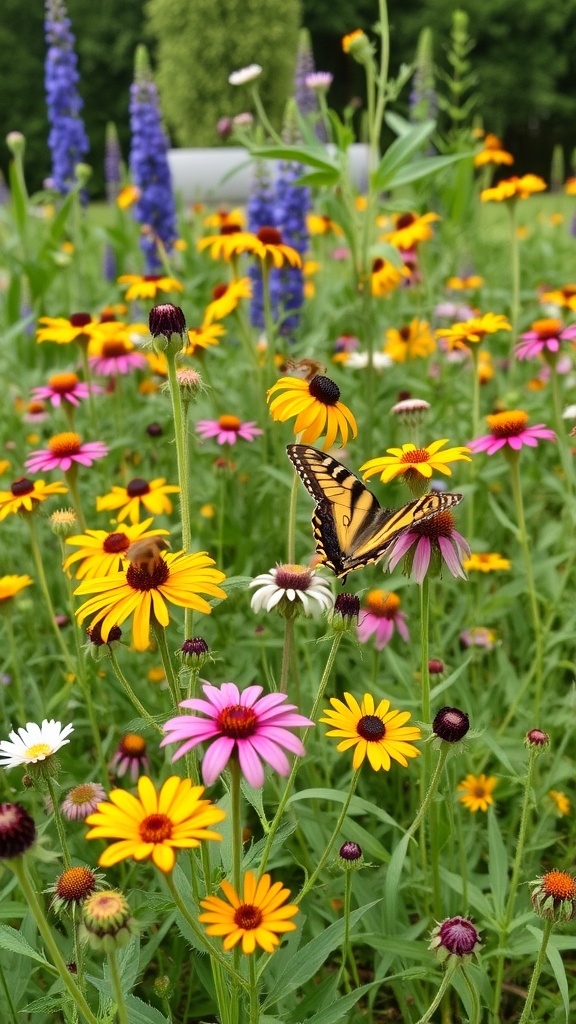
They thrive in local soil and climate, making them easier to care for. Plus, they attract pollinators, bringing more life to your garden.
More and more gardeners are choosing native plants, and for good reason! They’re better suited to the local climate, require less water, and attract pollinators like bees and butterflies. And the best part? You don’t have to go all-in—mixing native flowers with other climate-friendly plants creates a stunning and biodiverse garden.
3. Drought-Resistant Blooms Are Here To Stay
Drought-resistant blooms are a fantastic choice for gardens in 2025.
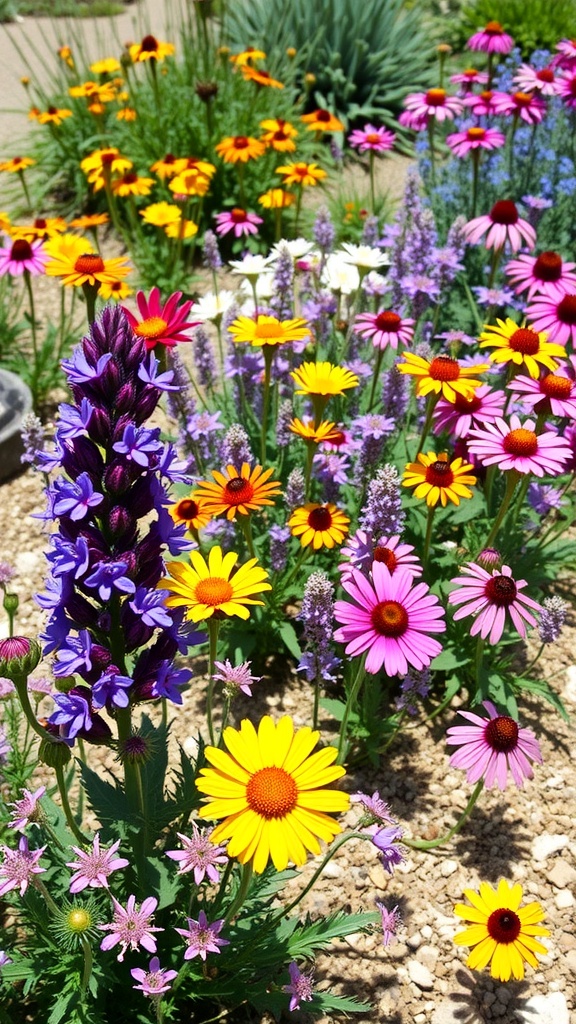
They thrive in dry conditions and come in so many colors and shapes. With these flowers, you can enjoy a beautiful garden while conserving water.
With hotter summers and unpredictable rainfall, low-maintenance, drought-resistant flowers are becoming a staple in gardens. Hardy perennials like Russian sage, catmint, yarrow, and coneflowers not only survive dry spells but also bring gorgeous color to your space. Just remember, ‘low-maintenance’ doesn’t mean ‘no maintenance’—these beauties still need occasional care.
4. Shrub Roses Are Making A Comeback
Shrub roses are stepping back into the spotlight, and it’s easy to see why.
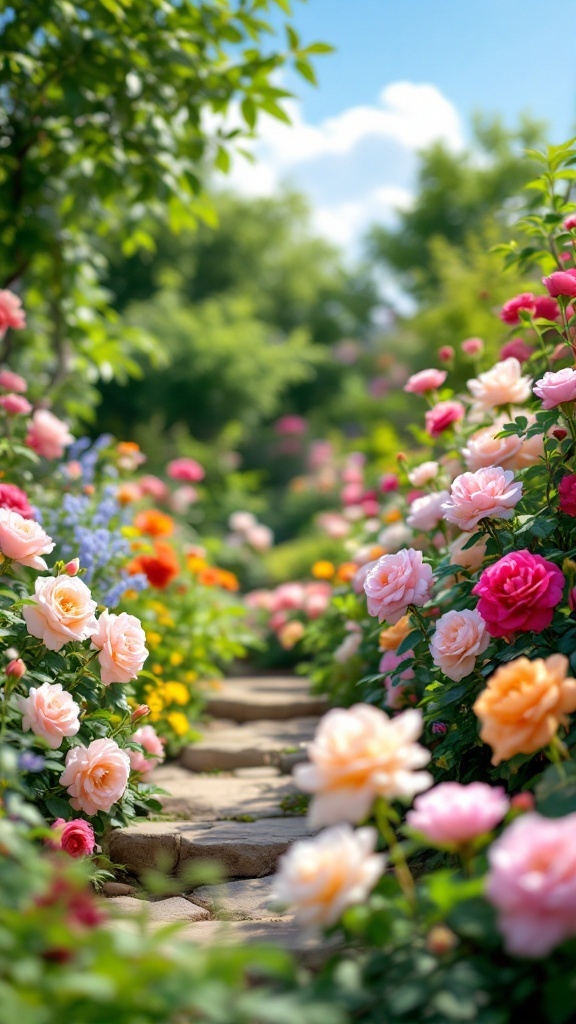
With their sturdy growth and abundant blooms, they can bring color and charm to any garden. Plus, these beauties are perfect for low-maintenance gardening, making them a hit among flower lovers!
Forget the fussy, high-maintenance roses of the past. This year, landscape rose bushes are taking center stage! They bloom longer, handle the heat better, and newer varieties even have their signature fragrance back. Whether you have a cottage garden or a modern landscape, shrub roses are a perfect fit.
5. Wildflower Meadows Are In Full Bloom
Wildflower meadows are becoming a favorite for gardens in 2025.
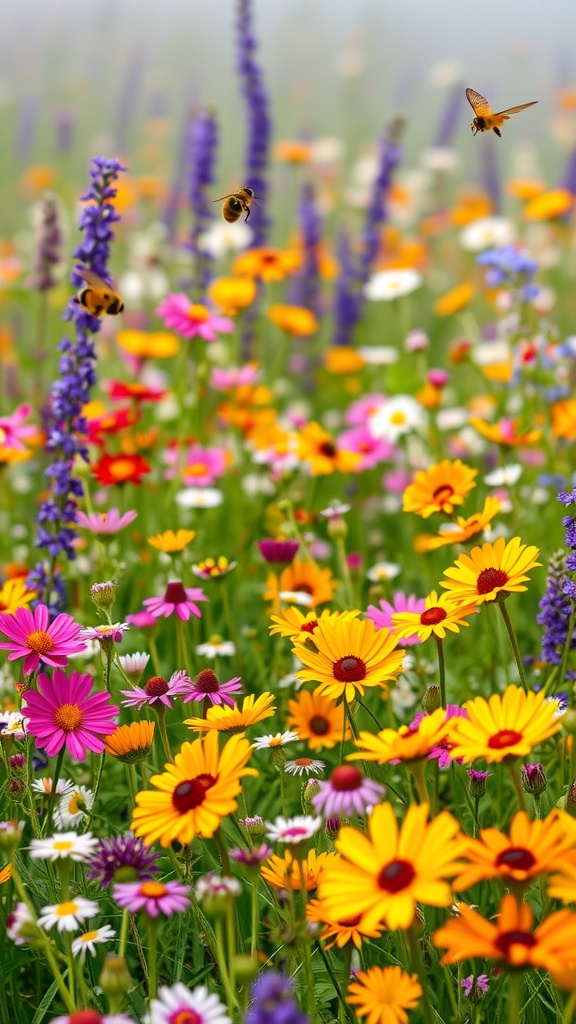
They bring a natural beauty that attracts butterflies and bees. Plus, they’re low maintenance, making them perfect for anyone looking to add splashes of color without much effort.
Want a garden that looks effortlessly beautiful? The wildflower meadow trend is here to stay! But don’t be fooled—these dreamy, natural-looking gardens require some planning. Planting flowers in clusters or ‘drifts’ creates that free-flowing, nature-inspired look. It’s the perfect way to bring a bit of the wild into your backyard.
6. Laid-Back, Imperfect Containers
For 2025, the trend of using laid-back containers is taking off. Think quirky, mismatched pots filled with vibrant blooms that create a relaxed vibe in your garden. These imperfect containers add charm and a touch of personality to any outdoor space.
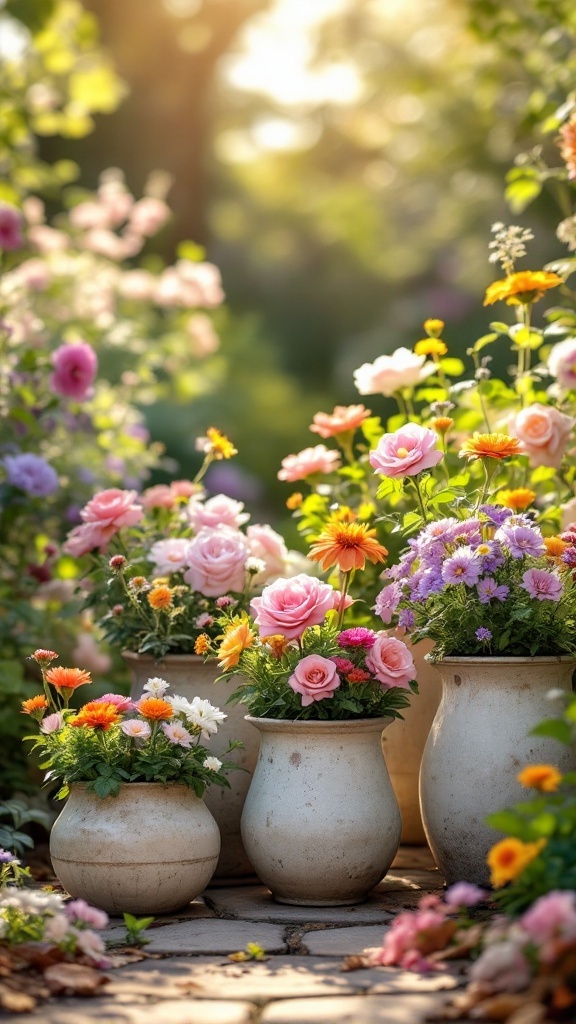
This year, container gardening is all about relaxed, natural arrangements. Think cascading flowers, wispy grasses, and earthy tones. No need for strict, structured designs—just let the plants do their thing! These effortless containers add instant charm to patios, porches, and entryways.
7. Bold Pops Of Color
Bright colors are a must for any garden in 2025!
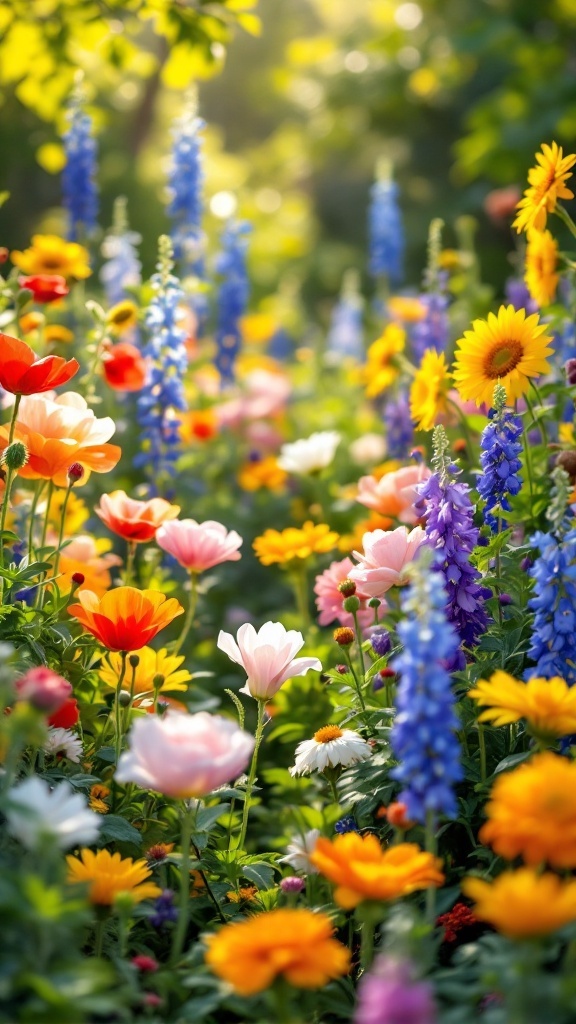
Think cheerful yellows, vibrant pinks, and deep blues that catch the eye and lift the mood. These bold blooms not only add energy to your space but also create a stunning visual impact that everyone will love.
While soft colors are trending, that doesn’t mean gardens will be dull! Many gardeners are adding vibrant pops of color to spice things up. Think bold purples, fiery oranges, and electric greens. Whether in small pots or sprinkled throughout flower beds, these lively shades make a big impact.
8. Pollinator-Friendly Gardens
Creating a pollinator-friendly garden is a fun and rewarding way to support local wildlife.
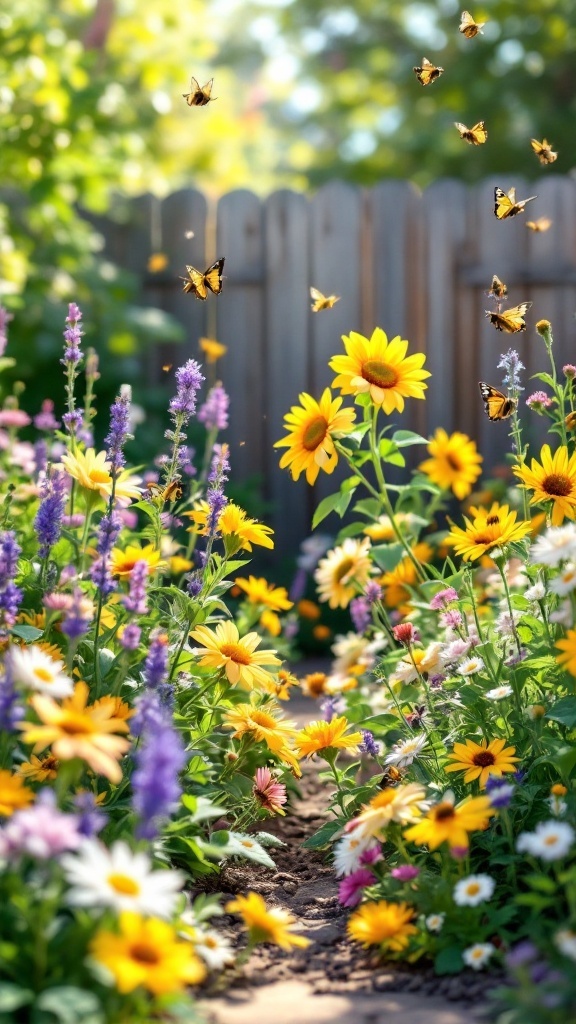
By planting flowers like sunflowers and daisies, you’ll attract bees and butterflies to your space. These vibrant blooms not only brighten your garden but also help maintain a healthy ecosystem.
Gardens aren’t just for us—they’re for the bees, butterflies, and birds too! Pollinator-friendly flowers like echinacea, milkweed, and lavender provide essential food and shelter for these important creatures. A beautiful garden that helps the environment? That’s a win-win!
9. Attracting Hummingbirds
To attract hummingbirds, fill your garden with bright, nectar-rich flowers.

Colors like red, yellow, and orange are particularly appealing to these tiny flyers. Consider planting zinnias and bee balm to create a buzzing paradise for these lovely creatures.
Who doesn’t love spotting a tiny hummingbird fluttering around? More gardeners are planting hummingbird-friendly flowers like lantana, salvia, and agastache to invite these magical little birds into their yards. Add a feeder, and you might just have hummingbirds visiting all season long!
10. Monochromatic Gardens For A Sleek Look
Monochromatic gardens are a stylish way to create a calming vibe in your outdoor space. By choosing blooms in a single color, you can craft a sleek and chic look that draws the eye.

These gardens not only look stunning but also make it easy to mix and match your favorite plants.
If you love a polished and stylish garden, the monochrome trend is for you. Choosing a single color palette—like shades of purple or soft pastels—creates an elegant and timeless look. It’s like ‘color drenching’ for your garden, and it’s absolutely stunning.
Ready To Bring These Trends To Life?
Getting your garden ready for the top flower trends of 2025 is easier than you think. Choose a mix of vibrant blooms and unique textures to create your own stunning display. With a little planning, your space can be a beautiful reflection of these exciting trends.
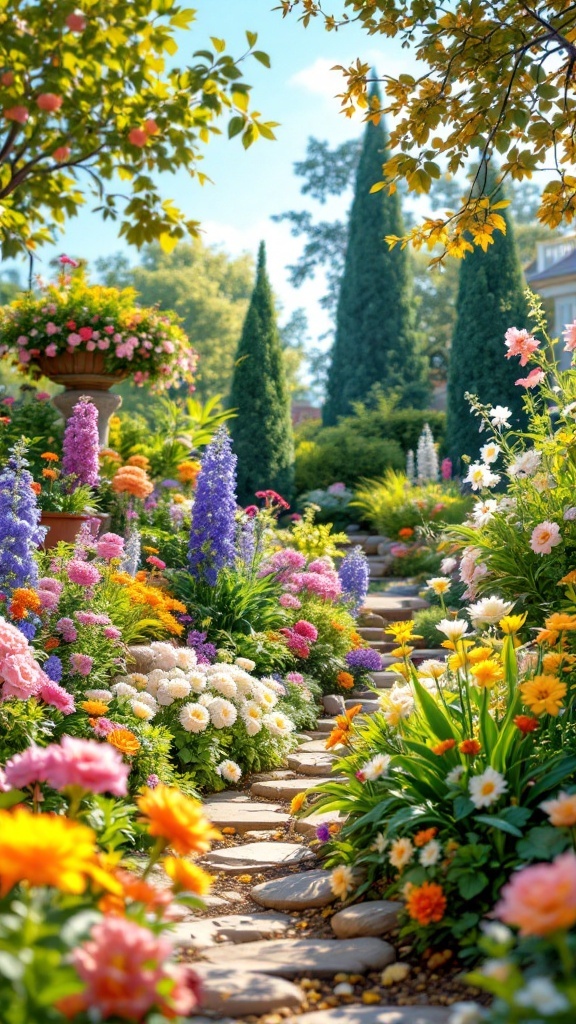
Whether you’re updating your entire garden or just adding a few new blooms, these trends offer plenty of inspiration. Which trend will you try this year? Let us know in the comments below!
And don’t forget—for more gardening tips, tricks, and ideas, visit GrowingOurGarden.com! Happy planting!
The Health Advantages of Gardening You Need to Know
Feeling stressed, out of shape, or disconnected from nature? Gardening can change your health, mood, and life outlook. It’s more than just making your yard look good.
Gardening helps your health by getting you moving. It can keep your weight and blood pressure in check. The CDC says gardening is exercise, from easy tasks like raking to hard work like shoveling.
It works many muscles, burns calories, and helps with weight and heart health.
Gardening also boosts your mental health. Being around plants lowers stress hormones. Studies show gardening can cut stress hormones by up to 30%.
It makes you feel relaxed and can help with anxiety and depression. People who garden often feel happier and more satisfied with life.
Gardening is a great way to stay active and connect with nature. Being outside and gardening can make you feel better. Research shows gardening can make you feel 70% more relaxed.
It also helps you sleep better and eat healthier. Growing your own food means you get to enjoy fresh, healthy meals.
Gardening offers many health benefits. It improves your fitness, mental health, and quality of life. So, why not start gardening today and enjoy these benefits?
Physical Benefits of Gardening as Exercise
Gardening is more than a hobby; it’s a great way to stay fit and healthy. It’s recognized by health experts, like the CDC, as a form of exercise. Gardening can greatly improve your overall health.
Cardiovascular Health
Gardening activities like raking and weeding can meet your daily exercise needs. These activities help keep your heart healthy and control blood pressure. Gardening increases your heart rate, improving blood flow and heart health.
A Japanese study showed that looking at plants can lower blood pressure and muscle tension. These are key signs of good heart health.
Weight Management
Gardening is a natural way to manage your weight. Light gardening can burn about 330 calories per hour. This is more than walking at a moderate pace for the same time.
A 2013 study found that people who gardened had lower BMIs than their neighbors. Gardening for 30 minutes a day can help prevent high blood pressure and aid in weight control.
Strength and Flexibility
Gardening also strengthens muscles and improves flexibility. Activities like digging and lifting work different muscle groups. These movements build strength, improve flexibility, and endurance.
Being in sunlight while gardening can also lower blood pressure and boost vitamin D. This adds to your overall physical health.
Gardening is a full-body workout that benefits both your body and mind. It offers a holistic approach to health and fitness.
How Gardening Improves Mental Health
Gardening is becoming more popular in the U.S., with about 1 in 3 people doing it. It offers many mental health benefits, like stress relief and better overall well-being. Gardening can also boost confidence, show progress in plant care, and make you more emotionally resilient.
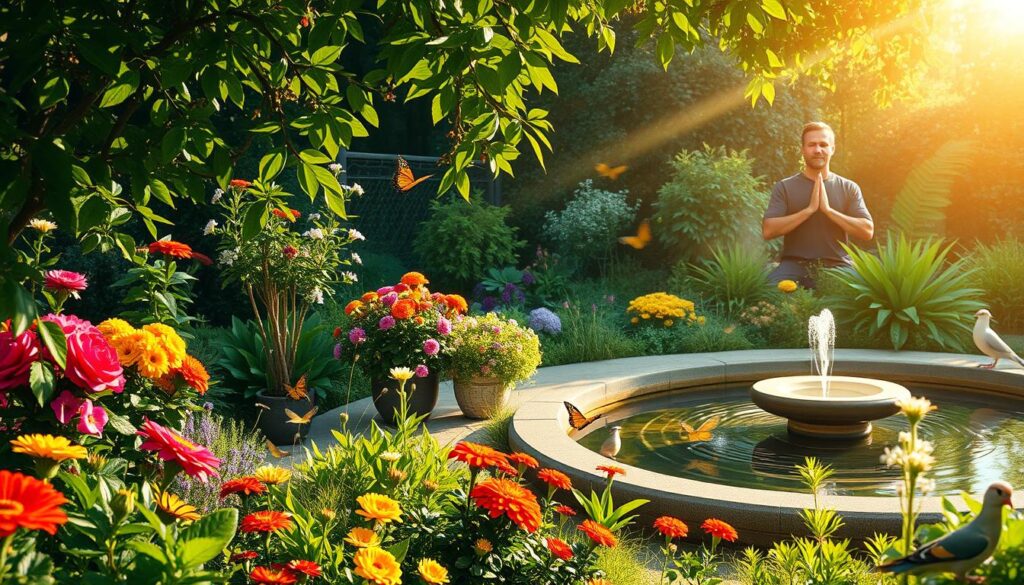
Reduction in Anxiety and Depression
Gardening is great for reducing anxiety and depression. Studies in the Journal of Environmental Horticulture found it lowers depression rates. Caring for plants and being outside releases dopamine, which improves mood and memory.
Green spaces also bring calm, making life feel more peaceful. This leads to a more positive view of life.
Boosting Mood and Well-Being
Gardening also lifts your mood and overall well-being. Gardeners feel more satisfied with life than those who don’t garden. Being part of community gardens and clubs makes you feel connected, boosting self-confidence and self-worth.
Gardening releases dopamine, making you happier. It can lead to longer, happier lives. Research shows gardeners’ mood improves by 55%.
| Activity | Mental Health Benefit |
|---|---|
| Gardening | 36% reduction in stress and anxiety |
| Community Gardening | 47% increase in social connections |
| Daily Gardening | Higher life satisfaction |
The Therapeutic Benefits of Gardening
Engaging in therapeutic gardening offers many benefits. It’s a practice with roots over 2,000 years old. It’s a powerful tool for improving well-being.
A study found that those in horticultural therapy see a 65% drop in anxiety. Gardening also boosts sleep quality by 30% for cancer patients.

About 80% of gardeners feel a great sense of accomplishment. This feeling boosts emotional satisfaction and confidence, especially for those recovering. Gardening improves balance, blood flow, and prevents muscle loss.
Community gardens increase social interactions by 25%. They help build social bonds and a sense of belonging. Spending time in these gardens reduces feelings of isolation by 40%.
Horticultural therapy is great for those undergoing chemotherapy. 70% of patients report better emotional well-being after gardening. Just one hour a week can greatly improve mental health.
Data from Texas A&M AgriLife shows gardening helps with PTSD and dementia. It also reduces depression and boosts happiness. Gardening lowers stress hormones and improves outlook on life.
The Health Benefits of Growing Your Own Food
Growing your own garden is more than just getting fresh produce. It brings many health benefits. It’s not just about the joy of picking your own food. It’s also about living a healthier life.
Improved Nutrition
One big plus of growing your own food is getting fresh, nutrient-rich produce. Fresh fruits and veggies have the most vitamins and minerals. This supports a healthy diet.
Research shows that fresh produce loses nutrients quickly. So, homegrown food is always the best choice.
A single tomato plant can give you up to 30 pounds of tomatoes. This means more chances to eat healthy. For example, a pint of cherry tomatoes costs about $5.00. This shows the food is both nutritious and affordable.
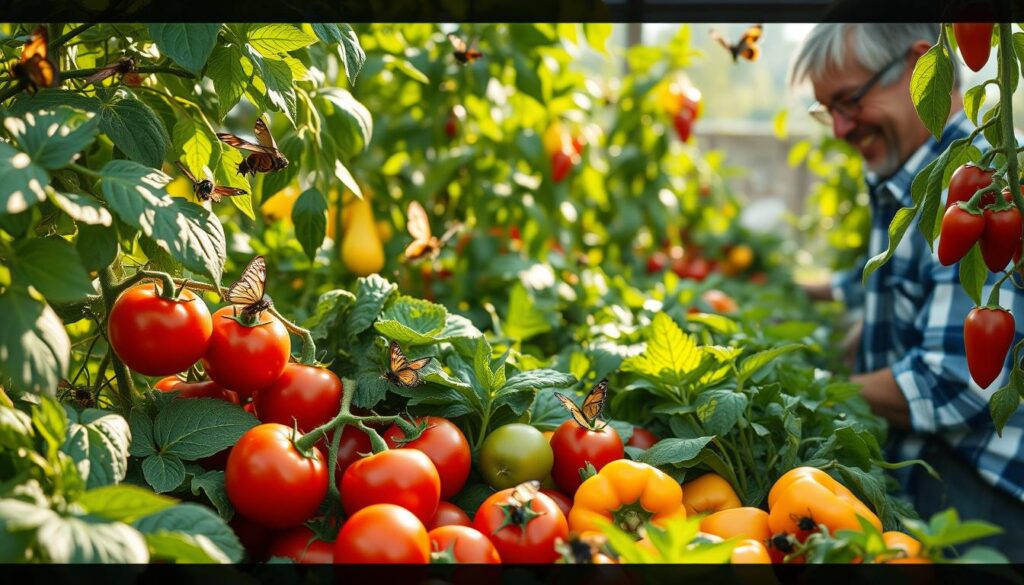
Healthy Eating Habits
Growing your own food helps you eat healthier. Studies show people who garden eat more fruits and veggies. This matches the Dietary Guidelines for a balanced diet.
Also, gardening gets kids to like veggies more. It teaches them to eat healthy and feel responsible for their food choices.
By growing different foods like purple cauliflower and golden beets, you get more nutrients. These foods have antioxidants and Vitamin A. They make your meals taste better and keep you healthy.
| Fruits and Vegetables | Health Benefits | Average Yield |
|---|---|---|
| Tomatoes | High in Vitamins A and C | 30 pounds per plant |
| Beets | Rich in Vitamin A and antioxidants | 20-25 pounds per 10 feet row |
| Cauliflower (Purple) | Contains cancer-fighting compounds | 5-6 heads per year |
Environmental Benefits of Home Gardening
The environmental benefits of home gardening are huge. They help reduce our environmental footprint. For example, food production is a big source of carbon emissions, with 25% coming from industrial farming, says the US Environmental Protection Agency. Gardening at home cuts down on these emissions because it doesn’t need long transport routes.

Commercial farming uses a lot of pesticides and fertilizers. In the US, these chemicals cost over $15 billion and $19 billion each year. But, home gardening lets you choose organic options. This keeps the soil healthy and helps grow food that’s good for you.
More and more people live in cities, with 54% of the world’s population in urban areas. This number is expected to rise to 59% by 2030. Home gardens in cities are very important. They can be bigger than commercial farms and natural areas, keeping cities green.
Home gardens also help wildlife. They provide homes for many animals, even in cities. This helps keep ecosystems balanced and makes cities more resilient.
Home gardens do more than just grow food. They help local food markets, support food security, and bring people together. They also help communities during tough times by making them more resilient.
In short, environmental benefits of home gardening are many. They offer a green solution to today’s problems. By gardening, you’re not just growing plants. You’re also helping the planet and fighting climate change.
Gardening Benefits for Seniors and Retirees
Gardening is more than a hobby for seniors and retirees. It brings health and emotional benefits that make life fulfilling and active.
Social Interaction
Gardening helps seniors connect with others. Joining community gardens or clubs can reduce loneliness. It lets them share interests and feel better emotionally.
Physical Activity and Cognitive Stimulation
Gardening is great exercise. It involves bending, lifting, and reaching, which keeps seniors mobile and helps with weight management. It also boosts Vitamin D levels, preventing osteoporosis and other health issues.
Gardening also sharpens the mind. Planning garden layouts and solving problems keeps the brain active. This helps fight cognitive decline that comes with age.
Using ergonomic tools and raised beds makes gardening easier for those with physical challenges. It still offers mental benefits as they plan and adapt their gardens. Gardening also improves coordination and balance, lowering the risk of falls.
In summary, gardening benefits for seniors and retirees include better physical health, sharper minds, and more social connections. It’s a great activity for this age group.
How to Use Gardening as a Mindfulness Practice
Gardening can be very therapeutic, offering a chance to practice mindfulness. It helps you stay in the moment and connect with nature. This can greatly improve your mental health.
Mind-Body Connection
Gardening strengthens the mind-body connection, making it a great mindfulness activity. Activities like planting and watering keep you focused on the present. This focus helps you relax and think more clearly.
Mindfulness meditation can help with chronic pain. It also boosts vitality and reduces disease symptoms in people with rheumatoid arthritis. Gardening offers similar benefits by making you feel connected to nature.
Stress Relief Through Gardening
Gardening is a natural way to reduce stress. Tasks like raking can calm your mind and body. Studies show that gardening can lower stress by 30% and improve mood by 23%.
Touching soil or smelling flowers can improve memory and cognitive function by 15%. Gardening also increases joy and satisfaction by 45%. It can even reduce anxiety and depression by 40%.
Gardening for 30 minutes a day can make you less reactive to stress. It promotes mental health and a balanced life. By making gardening a mindfulness routine, you can find peace and emotional stability.
A survey found that 80% of gardeners feel more relaxed and connected when gardening. For many, it’s like active meditation, improving mental health by 62%.
By using gardening as a mindfulness practice, you can improve your mental health. This connection to nature brings more than just relaxation. It adds purpose and serenity to your life.
| Benefits | Mindfulness Practice |
|---|---|
| Mind-Body Connection | Engaging in present-moment activities like planting and watering. |
| Stress Relief | Performing repetitive tasks such as raking and weeding to calm the mind. |
| Cognitive Function | Sensory engagement, such as touching soil or smelling flowers. |
| Mental Health Improvement | Experiencing a decrease in anxiety, depression, and stress levels. |
Gardening for Overall Well-Being
Gardening is more than just a hobby; it’s a way to stay fit, clear your mind, and feel good. During the COVID-19 pandemic in 2020, more people started gardening. This shows how gardening for overall well-being can improve health.
Gardening is like a workout, burning up to 400 calories an hour. It meets the CDC’s weekly exercise goal. It also helps fight age-related weight gain, studies show.
Gardening is good for your mind too. Being part of a community garden can boost mental health. It also helps reduce stress and anxiety by making you feel happy.
Gardening also sharpens your mind. A Korean study found that gardening can help dementia patients. It can even cut dementia risk by half, showing its power for brain health.
Growing your own food is a big plus of gardening. Foods like tomatoes and spinach are full of nutrients. They make your diet healthier and more nutritious.
- Physical fitness through calorie-burning activities
- Mental clarity with reduced stress and anxiety
- Emotional well-being through serotonin production
- Improved cognitive health by reducing the risk of dementia
- Enhanced nutrition from homegrown, pesticide-free produce
Gardening touches many areas of health, leading to better overall well-being. It encourages a balanced life and brings a sense of pride and happiness.
Conclusion
Gardening is a treasure trove of health benefits for everyone. It helps reduce anxiety and depression, and boosts mood and well-being. Studies show gardening can lower depression and anxiety, and improve life satisfaction.
Gardening is also a form of exercise that helps manage weight and improves heart health. Activities like digging and watering not only keep you fit but also sharpen your mind. It’s especially good for older adults, helping with memory care in Alzheimer’s disease.
Gardening also brings people together, especially for seniors. Community gardens like those at Lutheran Hillside Village and Laclede Groves create social bonds. These bonds are key for emotional, intellectual, and physical health. A meta-analysis shows gardening is a powerful tool for public health.
In short, gardening is a game-changer for health and well-being. It tackles physical, mental, and social health, making it a preventive and therapeutic activity. Gardening can improve your fitness, mood, and sense of community. Start gardening today and enjoy its many health benefits!
FAQ
How does gardening improve mental health?
Gardening can really help with anxiety and depression. It makes you feel better and more relaxed. Being around plants and green spaces lowers stress and boosts your mood.
What are the physical benefits of gardening?
Gardening is a form of exercise that’s good for your body. It helps you stay fit, keeps your heart healthy, and lowers blood pressure. Activities like raking and digging also improve your strength and flexibility.
How can gardening serve as a therapeutic practice?
Gardening brings joy and a sense of accomplishment. It helps you feel in control and learn new things. It’s even used in hospitals to help people recover from surgeries and other health issues.
What are the health benefits of growing your own food?
Growing your own food means you eat healthier. People who garden tend to eat more fresh fruits and veggies. This is key for a healthy diet and good health over time.
How does home gardening benefit the environment?
Home gardens add green spaces, clean the air, and cool down cities. They also help wildlife and fight climate change. This keeps our environment balanced and healthy.
Why is gardening beneficial for seniors and retirees?
Gardening keeps seniors active and mentally sharp. It helps them stay connected and engaged. Planning gardens and solving problems keeps their minds active while they stay physically fit.
How can gardening be used as a mindfulness practice?
Gardening connects your mind and body, reducing stress. Tasks like planting and weeding are calming. They help you focus and improve your mental health.
What are the overall health benefits of gardening?
Gardening is great for your body and mind. It keeps you fit, sharp, and happy. Regular gardening leads to a healthier, more balanced life.
Why is gardening a great hobby for families?
Gardening is a fun way for families to spend time together. It teaches kids about nature and responsibility. It also strengthens family bonds and promotes healthy living.
Are there surprising cognitive benefits to gardening?
Yes, gardening is good for your brain. It involves planning and problem-solving. These activities keep your brain active, which is important for staying sharp as you age.
How to Create a Small Vegetable Garden Layout Plan: A Beginner’s Guide
Ever dreamed of growing your own fresh veggies but thought you didn’t have enough space? Don’t worry, a small vegetable garden can be both rewarding and efficient. This guide will show you how to make the most of your space.
A small garden can be a haven of fresh produce right in your backyard. But starting can be tough. How do you make sure your small garden is full of food? The answer is in planning and layout.
Are you ready to start your small garden? Let’s dive into the secrets of creating a garden that’s both productive and space-saving. Your friends and neighbors will be jealous.
Key Takeaways
- Understand the advantages of a compact vegetable garden layout
- Learn how to strategically select the right vegetables for your small space
- Discover the power of vertical gardening techniques to maximize yield
- Explore tips for choosing the ideal garden location and size
- Gain insights on easy-to-grow vegetables perfect for beginner gardeners
Embrace a Small Garden Footprint
Gardening in a small space is great for city folks. It lets you use space well, perfect for container gardening, raised bed gardening, and community garden plots. With a small garden, you get fresh produce easily without the big work of a large garden.
Advantages of a Compact Vegetable Garden
A small garden layout is easy to keep up with. It has fewer weeds, less water, and easier plant checks, great for beginner gardeners. Plus, you can use smart gardening tricks like inter-cropping and vertical gardening to grow more in less space.
Determining the Ideal Garden Size
For urban gardening or city gardening, start with a small in-ground garden or a raised bed. A 10′ x 10′ in-ground or a 4′ x 4′ to 4′ x 8′ raised bed is good. These sizes let you grow many veggies without too much work. Remember to add paths for easy plant access. If you’re in a community garden, your plot size might be set, usually 10′ x 10′ to 20′ x 20′.
“Embracing a compact garden footprint allows you to enjoy the benefits of homegrown produce without the overwhelming task of maintaining a large plot.”
Plan Your Vegetable Selection Strategically
When planning a small vegetable garden, focus on growing what your household eats. Look at your grocery list and favorite recipes to see which vegetables you use most. Put those in your garden first, saving time and space for less used veggies.
Grow What You Eat
Think about each vegetable’s needs when planning your garden. Choose ones that grow well in a small space, like tomatoes, peppers, and leafy greens. Quick-growing veggies like radishes and bush beans can be planted often to use space well. Don’t use too much space for big, spreading plants unless you can train them to grow up.
Evaluate Vegetable Characteristics
- High-yield vegetables: Tomatoes, peppers, leafy greens
- Fast-growing crops: Radishes, bush beans
- Space-efficient plants: Compact, vertically trained varieties
Choosing the right vegetables for your small garden means a big harvest without wasting space. Pick the ones you and your family will love. Then, go for compact, high-yielding plants to fill your garden well.
Start with Seedlings for Efficient Space Utilization
Starting your vegetable garden with seedlings is smart when space is limited. Seedlings avoid the early stages of seed germination. This gives them a jump start on the growing season. It makes sure every inch of your garden works hard, without wasting space on seeds that might not grow.
Using starting vegetables from seed or using transplants has many perks for a small garden:
- Seedlings start growing earlier, so you can pick your crops sooner.
- Seed-starting tips help you grow strong seedlings ready for your garden.
- Nursery plants give you more vegetable options besides starting from seed.
- Seedlings need less space in your garden, letting you grow more plants in a small area.
Choosing seedlings makes your small vegetable garden more efficient and fruitful. It ensures a great harvest from your limited space.
“Utilizing seedlings is a game-changer for small-space vegetable gardeners – it allows you to hit the ground running and make the most of every inch of your garden.”
Maximize Vertical Gardening Techniques
Vertical gardening techniques can change the game for a space-saving garden. By training plants like cucumbers, pole beans, and some tomatoes to grow up, you save ground space. This method boosts your garden’s efficiency and adds beauty.
Vegetable Varieties Suitable for Trellising
Here are top vegetable varieties for growing vertically:
- Cucumbers
- Peas
- Pole beans
- Tomatoes
- Winter squash
DIY and Ready-Made Trellis Options
For a small garden, you can make your own DIY trellis using panels, wood frames, or old materials. Or, you can buy ready-made commercial trellises like pea supports, cucumber towers, and squash tunnels. These options help you use your garden space well and look great.
Using vertical gardening techniques lets you make the most of your small garden. You’ll get a big harvest in a small space.
Buy Locally Adapted Vegetable Varieties
When planning your small vegetable garden, picking the right plant varieties is key. Choose locally-sourced vegetable plants and regional plant varieties for better success. These plants are made for your local climate and soil.
Local farmers, gardeners, or nurseries are great places to find these plants. They offer farmers market plants and CSA seedlings that work well in your area. Big-box stores might not have plants suited for your garden.
“Locally adapted plants are more likely to thrive in your garden, requiring less maintenance and providing a higher yield of fresh, nutritious produce.”
By picking locally-sourced vegetable plants, your garden will grow well with little work. These plants know how to deal with your local weather, soil, and pests. This means your vegetables will grow big and healthy.
Check out local nurseries, farmers markets, and gardening groups for regional plant varieties. With some research and the right choices, you can make a beautiful and productive garden at home.
Small Vegetable Garden Layout Plan
Planning your small vegetable garden needs careful thought. Use intensive planting, companion planting, and succession planting to make the most of your space. Place taller plants on the north side to avoid shading smaller ones. Add pathways for easy access and include flowers or herbs to draw in beneficial insects for pest control and pollinator attraction.
Space-Saving Design Principles
Intensive planting means growing many vegetables, herbs, and flowers close together, saving space. Companion planting pairs plants that help each other out. For example, marigolds keep pests away, basil makes tomatoes taste better, and radishes help carrots grow well.
This approach increases your garden’s productivity and strength.
Companion Planting Techniques
Succession planting lets you plant different crops at various times in the same spot. This way, you can keep your garden busy all season and avoid empty spaces. Guild planting groups plants that work well together, like corn, beans, and squash. Intercropping also means growing two or more crops together in one spot, making your garden more efficient.
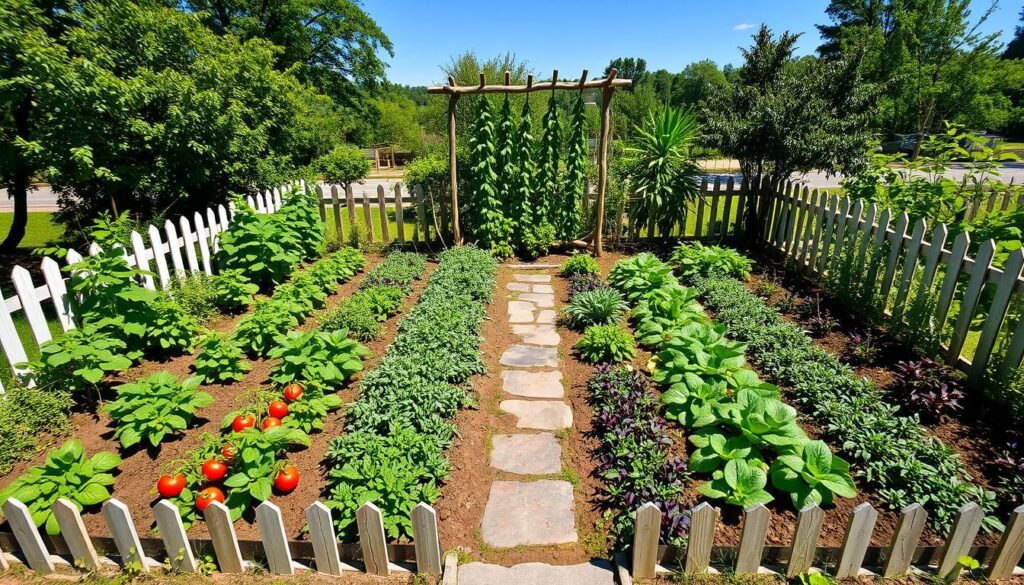
“Thoughtful companion planting can boost the overall productivity and resilience of your compact garden plot.”
Choose the Ideal Garden Location
Finding the right spot for your small vegetable garden is key to a great harvest. You should think about sunlight requirements, soil quality, drainage, and wind exposure when picking a garden spot.
Site Selection Criteria
Your garden needs at least 6-8 hours of direct sunlight every day. Stay away from places that are always in the shade or near buildings, trees, or other things that block the sun. Good soil that drains well is also crucial. This stops water from gathering and causing diseases in your plants. Add compost or other organic stuff to the soil to make it better.
Think about how much wind your garden gets too. Put your garden in a spot that’s not too windy. Wind can hurt your plants and stop them from growing big. Places that get a lot of wind dry out the soil and stress your plants.
Avoid places that often flood or get a lot of foot traffic. These can hurt your garden. With a good garden site evaluation, you can make the best spot for your small vegetable garden.
“The key to a thriving small vegetable garden is finding the perfect location that meets the unique needs of your plants.”
Determine the Appropriate Garden Size
Starting a small vegetable garden means choosing the right size is key. Experts suggest beginners start with a 10′ x 10′ in-ground garden or a 4′ x 4′ to 4′ x 8′ raised bed. These sizes let you grow many veggies without feeling swamped by upkeep.
If you’re using a community garden, the plot size is usually set, from 10′ x 10′ to 20′ x 20′. Make sure to include paths for easy plant access, no matter the garden size.
| Garden Type | Recommended Dimensions |
|---|---|
| In-Ground Garden | 10′ x 10′ |
| Raised Bed | 4′ x 4′ to 4′ x 8′ |
| Community Garden Plot | 10′ x 10′ to 20′ x 20′ |
Think about the small garden size, raised bed dimensions, and in-ground garden layout to make a great community garden plot. This way, you’ll have a garden that fits your needs and helps you succeed in gardening.
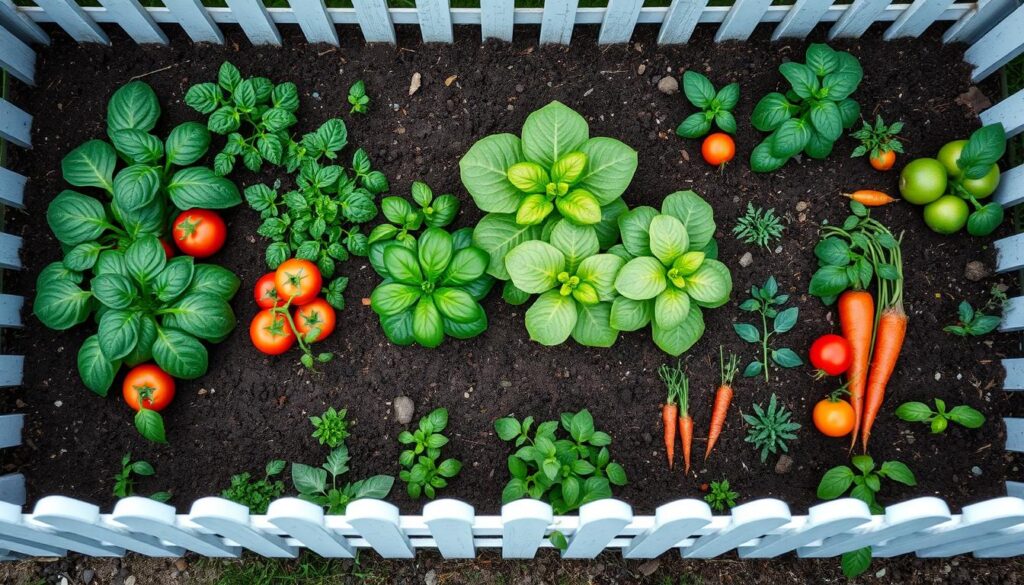
“The key to a successful small vegetable garden is starting with the right size and layout. Don’t be afraid to start small – you can always expand later!”
Select Easy-to-Grow Vegetables for Beginners
Starting a small beginner-friendly vegetable garden is a great idea. Choose easy-to-grow and maintain crops like lettuce, green beans, radishes, high-yield crops like tomatoes and zucchini, and fast-maturing plants such as peppers, beets, carrots, leafy greens, and peas. These plants are reliable, easy to care for, and perfect for small gardens.
Adding a few of these versatile vegetables to your garden ensures success. They help you gain gardening skills and confidence. Plus, they are packed with nutrients, making your garden a source of fresh, healthy food.
| Vegetable | Characteristics |
|---|---|
| Lettuce | Grows quickly, tolerates partial shade, easy to harvest |
| Green Beans | High-yielding, compact plants, low maintenance |
| Radishes | Fast-maturing, space-efficient, versatile in recipes |
| Tomatoes | Productive, can be grown in containers, wide variety of types |
| Zucchini | Prolific yields, bushy plants adapt well to small gardens |
Choosing these beginner-friendly vegetables leads to a thriving garden. You’ll enjoy high-yield crops and low-maintenance gardening in a small space. With the right plants and care, you’re on your way to a rewarding harvest.
Conclusion
Starting a small vegetable garden is easy for beginners. You can make the most of a small space by using smart gardening tips. This way, you can grow a lot of food in a little area.
Choosing the right vegetables and using vertical gardening are key to success. These methods help you grow more in a small garden. You can make your small garden a great source of fresh food for your family.
Even if you’re new to gardening, these tips can help you succeed. Your small garden can be a place of joy and give you fresh, tasty food. So, get creative and start your small garden project today.
FAQ
What are the advantages of a compact vegetable garden?
A small garden takes less time to care for, with less weeding and watering. It’s great for beginners because it’s not too big. You can use space wisely with techniques like vertical gardening.
What are the recommended starting sizes for a small vegetable garden?
Start with a 10′ x 10′ in-ground garden or a 4′ x 4′ to 4′ x 8′ raised bed. These sizes are perfect for beginners and fit a variety of vegetables. Community plots often have sizes from 10′ x 10′ to 20′ x 20′.
How should I select vegetables for a small garden?
Choose vegetables you and your family eat often. Look at your grocery list and favorite recipes. Focus on growing what you use most, not what you don’t eat often.
Why is it beneficial to start with vegetable seedlings?
Starting with seedlings is better for small gardens. It skips the early stages of growth and gets plants ahead. This makes sure every part of your garden is used well.
What are the benefits of incorporating vertical gardening techniques?
Vertical gardening is great for small gardens. Use trellises for plants like cucumbers and beans. This saves ground space and makes your garden look better.
How can I design an efficient layout for a small vegetable garden?
Plan your garden carefully to use space well. Use intensive and companion planting. Place taller plants on the north side and add paths for easy access. Include flowers to help insects.
What factors should I consider when selecting the location for a small vegetable garden?
Choose a spot that gets 6-8 hours of sunlight, has good drainage, and is safe from strong winds. Stay away from flooded areas and heavy footpaths. Improve poor soil with compost for better plant growth.
What are some easy-to-grow vegetable options for beginner gardeners?
Beginners should try growing lettuce, green beans, radishes, tomatoes, zucchini, peppers, beets, carrots, leafy greens, and peas. These are easy to care for and fit well in small spaces.
Source Links
- How to start a small vegetable garden and make the most of it – https://www.creativevegetablegardener.com/how-to-start-a-small-vegetable-garden/
- Vegetable Gardening for Beginners: The Complete Guide – https://www.almanac.com/vegetable-gardening-for-beginners
- Small Vegetable Garden Plans and Layouts – https://www.almanac.com/small-vegetable-garden-plans-and-layouts
DIY Garden Projects for Small Spaces: Upcycling Ideas to Maximize Your Garden
Feeling stuck with your small outdoor area? Get ready for a big change! This article will show you how to turn a tiny space into a lush garden. You’ll learn to use everyday items as planters and build raised beds on a budget. These ideas will help you make the most of your small garden and create a beautiful spot to relax.
Key Takeaways
- Discover upcycling ideas to turn everyday items into unique planters for your small space garden
- Explore vertical gardening solutions to maximize your limited square footage
- Learn how to transform a balcony or patio into a thriving urban oasis
- Create affordable raised bed gardens using reclaimed materials
- Ignite your imagination with enchanting fairy garden projects
- Grow your own herb garden, even in the smallest of indoor or outdoor spaces
- Decorate your garden on a budget with DIY upcycled projects
Feeling inspired yet? Get ready to unleash your creativity and transform your small space into a magnificent garden oasis. But first, let’s tackle the question that’s likely on your mind: How can I create a beautiful, functional garden in a limited space? The answers are about to unfold, so keep reading!
Unleash Your Creativity with DIY Container Gardens
Take your small-space gardening to the next level with DIY container gardens. Turn everyday items like buckets, suitcases, and old bookshelves into unique planters. These budget-friendly options add charm to your outdoor space.
Repurposing Everyday Items as Planters
Get creative and turn household items into beautiful DIY container gardens. Use vintage suitcases, wooden crates, or galvanized buckets for a unique look. The possibilities are endless, so let your imagination soar!
Creative Vertical Gardening Solutions
Want to make the most of your limited space? Try vertical gardening. Hang planters, use tiered stands, or build a vertical garden with salvaged materials. These ideas let you grow flowers, herbs, and small vegetables without taking up much space.
Enjoy the beauty of small space gardening with these DIY container garden ideas. Let your creativity shine and watch your garden come alive with personality.
Transform Your Balcony into an Urban Oasis
Make the most of your balcony and turn it into a green, welcoming spot with these balcony gardening tips. You can make a cozy outdoor area that shows off your style and love for urban gardening, even with a small patio or balcony.
Begin by looking into ways to save space for your small space gardening needs. Use hanging baskets full of flowing flowers, or put up vertical planters to make your balcony garden look interesting. Small raised beds are great too. They look good and are perfect for your favorite plants.
Pick plants for your balcony that do well in pots and can handle city life. You can choose from beautiful vines, bright annuals, and tough perennials. Plan your garden to look good together and show off your style.
“Transforming my balcony into a little urban oasis has been truly rewarding. It’s a sanctuary where I can reconnect with nature, even in the heart of the city.”
With some creativity and DIY skills, your balcony can become a peaceful spot that feels like a different world. Enjoy the beauty of balcony gardening and see your urban oasis grow into a lively, useful, and beautiful place.
Maximize Your Patio with Raised Bed Gardens
If you’re short on garden space but love gardening, raised bed gardens are ideal for your patio or small area. These beds improve soil quality and make gardening easier. They’re great for raised bed gardening and patio gardening fans.
Upcycling Materials for Affordable Raised Beds
Creating raised beds with upcycled materials is a smart way to save money and be creative. Use old wood, bricks, or big containers to make upcycled raised beds for your small space gardening needs.
- Transform reclaimed wood into custom-sized raised beds
- Upcycle bricks, stones, or cinder blocks to create sturdy, long-lasting frames
- Repurpose large containers, such as barrels or galvanized tubs, into mobile raised gardens
Be creative with materials to design your own unique raised bed gardens. This way, you can make the most of your patio space and show off your style. Enjoy the fun of DIY gardening and turn your small area into a lush, productive spot.
DIY garden projects for small spaces
Creating a garden in a small outdoor area can seem tough, but with the right DIY projects, you can make even the tiniest spots a lush oasis. This section offers inspiring ideas for making the most of your small garden space. From creative container gardening to innovative vertical solutions, there’s something for everyone.
Embrace the Power of Container Gardening
Containers are perfect for gardeners with limited space. Use items like old buckets, wooden crates, or hanging baskets to create unique planters. This way, you can add personality to your DIY garden projects beyond the usual flower pot.
Vertical Gardening for the Space-Savvy
If you’re short on floor space, consider vertical gardening. This method lets you grow plants, herbs, and small vegetables in a small area. Build DIY trellises, wall-mounted planters, or tiered stands to use your small space gardening space wisely.
Whether you’re working with a balcony, patio, or windowsill, these DIY projects for urban gardening and container gardening can help you bring your green dreams to life. No matter the size of your outdoor area, these ideas offer endless possibilities.
| DIY Garden Project | Benefits | Difficulty Level |
|---|---|---|
| Upcycled Container Garden | Adds charm and personality, maximizes available space | Easy |
| Vertical Herb Garden | Saves floor space, provides easy access to fresh herbs | Moderate |
| Tiered Planter Stand | Enhances visual interest, allows for diverse plantings | Intermediate |
Fairy Garden Magic: Enchanting Miniature Worlds
Unleash your creativity and turn your small space into a fairy garden oasis! These gardens are great for gardeners who love the whimsical and magical. They let you add magic to tiny outdoor areas, like balconies or patios.
Whimsical Fairy Garden Ideas for Small Spaces
Fairy gardens need imagination and creativity. Use items like teacups, birdhouses, and old shoes as planters. Add stones, twigs, and moss for a woodland feel. Include fairy houses and other fun accessories to make it magical.
- Upcycle everyday items into unique fairy garden containers
- Use natural elements like rocks, sticks, and dried flowers for a rustic touch
- Include whimsical fairy statues, miniature furniture, and other enchanting accents
With creativity and a bit of fairy dust, you can make a magical world in your garden. Enjoy making your own fairy garden and let your imagination run wild!
Herb Gardens: Spice Up Your Indoor and Outdoor Spaces
Take your cooking to the next level with a vibrant herb garden, even in small spaces. Whether you have a balcony, patio, or a tiny indoor spot, you can grow a lush herb garden. This will add fresh, homegrown flavors to your meals.
Discover DIY herb garden projects that make the most of your space. Use tiered planters and vertical walls to grow many herbs in a small area. This way, you can have a small space gardening spot right at your fingertips.
When picking herbs for your herb gardens, think about the climate, sunlight, and what you like to cook. Great choices include basil, rosemary, thyme, mint, and parsley. These herbs grow well in different conditions and add flavor to many dishes.
| Herb | Ideal Conditions | Culinary Uses |
|---|---|---|
| Basil | Full sun, well-drained soil | Pesto, tomato dishes, salads |
| Rosemary | Full sun, dry, well-drained soil | Roasted meats, potatoes, focaccia |
| Thyme | Full sun, well-drained soil | Soups, stews, sauces, marinades |
| Mint | Partial shade, moist soil | Teas, cocktails, salads, desserts |
| Parsley | Full sun to partial shade, well-drained soil | Garnishes, sauces, salads, soups |
Enjoy the fun of DIY garden projects. Turn your indoor or outdoor area into a lush herb oasis. This will make your cooking adventures better and add natural beauty to your home.
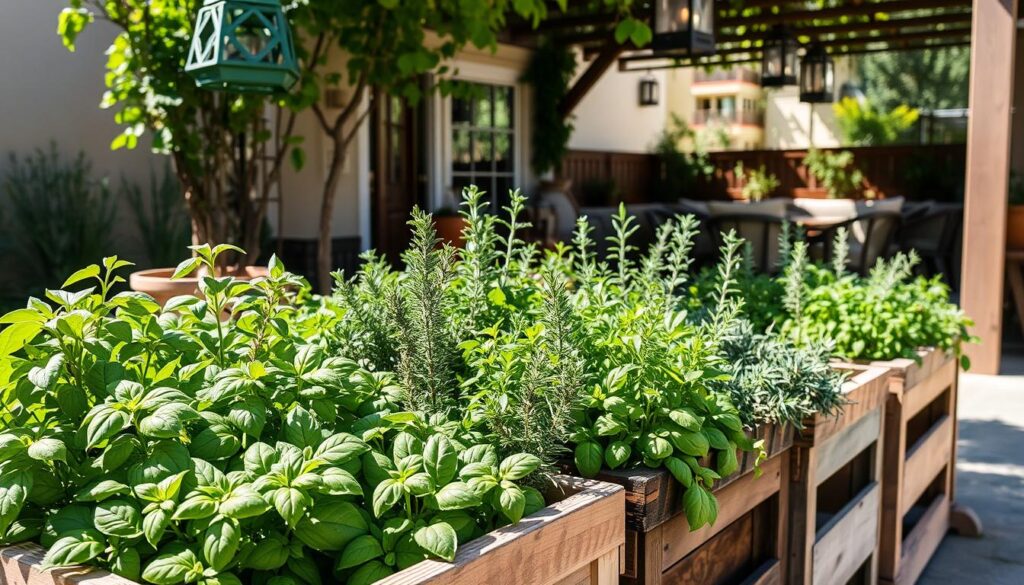
Garden Decor on a Budget: Upcycling Ideas
Don’t think you need to spend a lot to make your small-space garden look great. Get creative and turn everyday items into beautiful garden decorations. Use things you might throw away to add a personal touch and interest to your garden without spending a lot.
Painted Rock Garden Markers
Show off your artistic skills by making your own garden markers with rocks from your yard. Paint them with bright designs or inspiring. It’s an easy and cheap way to make your garden decor stand out. Place them in your plant beds or along paths for a unique, DIY look.
Rustic Garden Decor from Natural Materials
Use nature to create beautiful garden decor. Turn old wood, pinecones, driftwood, or dried flowers into unique decorations. These DIY garden projects with natural materials will add warmth and rustic beauty to your garden.
| Upcycled Item | Repurposed Garden Decor |
|---|---|
| Old Ladder | Vertical Plant Display |
| Discarded Buckets | Colorful Planter Boxes |
| Vintage Birdhouses | Whimsical Accent Pieces |
“Upcycling allows you to create beautiful, one-of-a-kind garden decor that reflects your personal style and values.”
By using upcycling, you can give old items a new life. Turn your small-space garden into a beautiful oasis. Let your creativity show and make DIY garden projects that are both sustainable and unique.
Small Space Gardening Tips for Beginners
If you’re new to small space gardening, don’t worry about the limited space. With some tips and tricks, you can make even a small balcony or backyard into a garden oasis. Start your beginner gardening journey and see how container gardening and raised bed gardening can open up new possibilities.
First, look at the space you have and how much sunlight it gets. This will guide you in picking the right plants for your spot. Container gardening is great for small areas because you can control the soil and where your plants go. Choose plants that are small but still pack a punch in terms of beauty and growth.
For your raised bed garden, plan your layout to use space well. Raised beds improve the soil and drainage and make gardening easier. You can make your own raised beds using recycled materials, which is both affordable and eco-friendly.
- Begin with a few easy plants like herbs, leafy greens, or small tomatoes.
- Use vertical space with trellises, hanging planters, or stacked containers.
- Get tools and storage that save space to keep your garden tidy.
- Try companion planting to get more out of your small garden space.
The secret to great small space gardening is being open-minded, creative, and eager to learn. Embrace the challenge and enjoy making your small outdoor space a lush, productive garden.
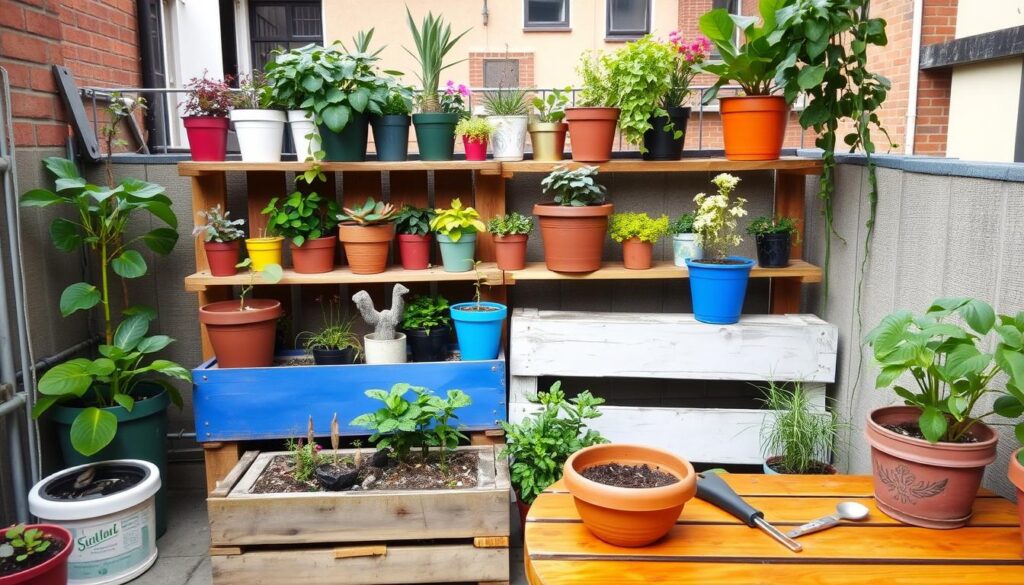
Conclusion: Embrace the Joy of DIY Gardening
As you finish this journey, we urge you to dive into the joy of DIY gardening, even in small spaces. Upcycling, creativity, and hard work have shown us the endless ways to make a beautiful, useful green space. This article has highlighted how you can make a garden that fits your needs and tastes.
Whether you’re making a colorful container garden, turning your balcony into a city oasis, or building fairy gardens, let your inner artist shine. By trying out the DIY garden projects, you’ll see the perks of small, eco-friendly gardening. You’ll enjoy the excitement of seeing your plants grow and the pride of making your own green space.
So, grab your tools, get ready, and start your DIY gardening adventure. The happiness, peace, and personal joy waiting for you are incredible. Take this path, and watch your small space turn into a lush, lively oasis that shows off your unique style and personality.
FAQ
What are some creative DIY container gardening ideas for small spaces?
This article shows you how to turn everyday items like buckets and suitcases into unique planters. It also talks about hanging planters and plant towers for vertical gardening. These ideas let you grow flowers, herbs, and veggies in small spaces.
How can I transform my balcony into a lush, inviting urban oasis?
For a cozy balcony garden, use hanging baskets and vertical planters. The article suggests small raised beds and tips for choosing the right plants. It helps you arrange your balcony garden for beauty and functionality.
What are some affordable, DIY raised bed options for my patio garden?
You can make raised bed gardens with repurposed wood and containers. The article explains the benefits of raised beds and how to build them. It helps you use your patio space well.
How can I create a whimsical miniature fairy garden in my small outdoor space?
For a fairy garden, use repurposed containers and natural materials. The article gives ideas for designing these magical spaces. It shows how to make your garden a place of wonder and joy.
What are some tips for starting an herb garden in my small-space garden?
Try DIY herb garden projects like tiered planters and vertical walls. The article helps you choose the best herbs and design a space-saving garden. It’s perfect for indoor and outdoor settings.
How can I add budget-friendly DIY decor to my small-space garden?
Use items like bottles and birdhouses to decorate your garden. The article also shows how to make garden markers and rustic decor with natural materials. This lets you add a personal touch without spending a lot.
What are some essential tips for a beginner gardening in small spaces?
Container gardening and raised beds are great for small spaces. The article offers advice on choosing plants, managing sunlight, and using space well. It also covers budgeting, DIY projects, and sustainable gardening to help you succeed.
Source Links
- DIY Gardening Ideas: A Guide to Creating a Spring Garden – https://thediymommy.com/diy-gardening-ideas-a-guide-to-creating-a-spring-garden/
- Inexpensive Raised Garden Bed Ideas: DIY Inspiration – https://savvygardening.com/inexpensive-raised-garden-bed-ideas/
- Landscaping on a Budget: DIY Garden Design – https://www.roundrockgardens.com/post/landscaping-on-a-budget-diy-garden-design
Watering Techniques for Small Gardens: Ensuring Your Plants Thrive
Ever wondered if you’re watering your small garden right? Getting it right is crucial for a lush oasis. With many watering methods, it’s hard to know where to begin. How do you make sure your plants get enough moisture without causing problems like drought or too much water?
Key Takeaways
- Discover the importance of consistent moisture for plant health and preventing drought stress.
- Explore efficient watering solutions like soaker hoses, drip irrigation systems, and hand watering.
- Learn how to optimize watering for small gardens, containers, and raised beds.
- Understand the benefits of water conservation techniques like timers, moisture sensors, and mulching.
- Gain insights on using specialized watering systems like terracotta plant stakes and olla watering.
The Importance of Proper Watering
Getting the importance of proper watering right is key for small garden plants. If you don’t water enough, plants may wilt, grow poorly, or even die. On the other hand, too much water can cause root rot and other issues. Knowing what your plants need and how to water them well helps them grow strong.
Preventing Drought Stress and Overwatering
Finding the right balance is crucial for healthy plants. Not enough water makes leaves wilt and stems break easily. Too much water can cause root rot and diseases. It’s important to get it just right.
Benefits of Consistent Moisture for Plant Health
Consistent moisture is key for healthy roots, photosynthesis, and growth. When plants get the right water at the right time, they grow strong and healthy. This leads to better plant health and a lush garden.
“The secret to a flourishing small garden lies in the careful management of water. By understanding the importance of proper watering, you can unlock the true potential of your plants and create a thriving oasis in your own backyard.”
Soaker Hoses: A Seamless Solution
If you’re looking for an easy way to water your small garden, soaker hoses are perfect. These hoses slowly release water into the soil. This keeps your plants moist without wasting water on runoff or evaporation. They work great for raised beds and in-ground gardens, watering plants right at their roots.
Soaker hoses make sure your garden gets water evenly. They don’t just spray water everywhere like sprinklers do. So, every part of your garden gets the right amount of water. This stops plants from getting stressed from lack of water and keeps them healthy and colorful.
Using soaker hoses saves you time too. Just set them up and turn on the water. You won’t have to water each plant by hand. This makes soaker hoses a smart choice because they use water wisely.
| Feature | Benefit |
|---|---|
| Porous Design | Even Water Distribution |
| Delivers Water to Roots | Promotes Plant Health |
| Time-Saving Setup | Efficient Watering |
Soaker hoses are great for any garden, big or small. They make sure your plants get the water they need, even when it’s dry and hot. With soaker hoses, you can relax knowing your garden is well taken care of.
“Soaker hoses have been a game-changer for my garden. I no longer worry about uneven watering or wasting precious water. They’ve saved me so much time and effort.”
– Gardening Enthusiast
Drip Irrigation Systems: Precision Watering
Drip irrigation systems are great for small gardens. They send water straight to each plant’s roots through tubes and emitters. This means you don’t waste water like you do with traditional methods.
Customizable and Efficient
Drip irrigation systems let you tailor the water flow to your plants’ needs. You can make sure each plant gets just the right amount of water. This leads to healthier plants and saves water, which is good for the planet.
Expandable for Garden Growth
As your garden grows, so can your drip irrigation system. You can add more tubing and emitters as needed. This makes sure your watering system keeps up with your garden, helping your plants thrive for years.
“Drip irrigation systems are a game-changer for small garden owners. They provide the precision, efficiency, and expandability needed to keep your plants thriving, no matter how your garden grows.”
| Feature | Benefit |
|---|---|
| Precision Watering | Delivers water directly to the root zone, reducing waste and promoting healthier plant growth |
| Customizable | Allows you to adjust water flow and coverage to meet the specific needs of your plants |
| Expandable | Easily adapts to your growing garden, ensuring your watering system keeps pace with your evolving planting area |
| Water-efficient | Minimizes water usage compared to traditional overhead watering methods |
Hand Watering: Personal Touch with Proper Tools
Hand watering is a great way to care for small gardens or delicate plants. It lets you water exactly where needed and adjust the flow. Using the right tools is key to making this method work well.
A watering can is perfect for small areas. It waters gently and doesn’t harm the soil or plants. For bigger areas, a garden hose with an adjustable nozzle is better. It lets you change the water pressure and coverage easily. A watering wand is also useful for reaching plants in hard spots and watering at their base.
Hand watering gives you control and lets you water just the right amount. It’s great for plants that are sensitive or need special care. This way, you can avoid watering too little or too much.
“Hand watering is like having a personal conversation with your plants. It’s a chance to really connect with their needs and nurture them with the attention they deserve.”
So, whether you have a small herb garden or a big flower bed, don’t overlook the value of hand watering with the right tools. With some time and effort, you can make sure your plants are well taken care of, one watering at a time.
Watering techniques for small gardens
Keeping a small garden healthy needs a smart watering plan. Whether your garden is on raised beds or in the ground, knowing the best way to water is key. Let’s look at some top methods to keep your garden moist and lively.
Raised Bed Oasis
For raised beds, soaker hoses and drip irrigation are great picks. These systems spread water evenly, cutting down on waste and making sure your plants get enough water. They water the roots directly, so your plants stay healthy without getting too wet.
In-Ground Oasis
In-ground gardens do well with sprinklers, mulch, and rain barrels. Sprinklers cover your garden evenly and water it well. Mulch keeps the soil moist, so you water less often. And using rain barrels lets you use nature’s water to help with your garden’s needs.
| Watering Technique | Recommended for | Benefits |
|---|---|---|
| Soaker Hoses | Raised Beds | Even moisture distribution, targeted root zone watering |
| Drip Irrigation | Raised Beds | Precision watering, efficient water usage |
| Sprinklers | In-Ground Gardens | Comprehensive coverage, easy installation |
| Mulching | In-Ground Gardens | Retains soil moisture, reduces watering frequency |
| Rain Barrels | In-Ground Gardens | Collects rainwater for supplemental watering |
Adjusting your watering to fit your garden’s needs helps your plants get just the right amount of water. This way, they’ll do well all season long.
Sprinklers: Coverage for Large Areas
Sprinklers are great for watering big areas in your small garden, like lawns or big planting beds. They come in different types, like oscillating and rotating ones. These tools make watering easy and efficient.
The tripod sprinkler is a top choice. It connects to your garden hose and can be set to water specific areas. It’s perfect for keeping your garden lush and healthy.
Sprinklers are all about coverage. They let you water big parts of your garden with just one setup. This saves time and effort compared to hand-watering or using soaker hoses for small areas.
Ease of use is another big plus of sprinklers. Many can be programmed or adjusted to water at certain times. This ensures your plants get the right amount of moisture for growth and health.
| Sprinkler Type | Coverage Area | Ease of Use |
|---|---|---|
| Oscillating Sprinkler | Up to 3,600 sq ft | Simple to set up and adjust |
| Rotary Sprinkler | Up to 5,000 sq ft | Customizable coverage patterns |
| Tripod Sprinkler | Up to 4,000 sq ft | Portable and easily adjustable |
When picking a sprinkler for your garden, think about your lawn or bed size, coverage needs, and how easy you want it to be. The right sprinkler system makes sure your plants get the moisture they need to do well.
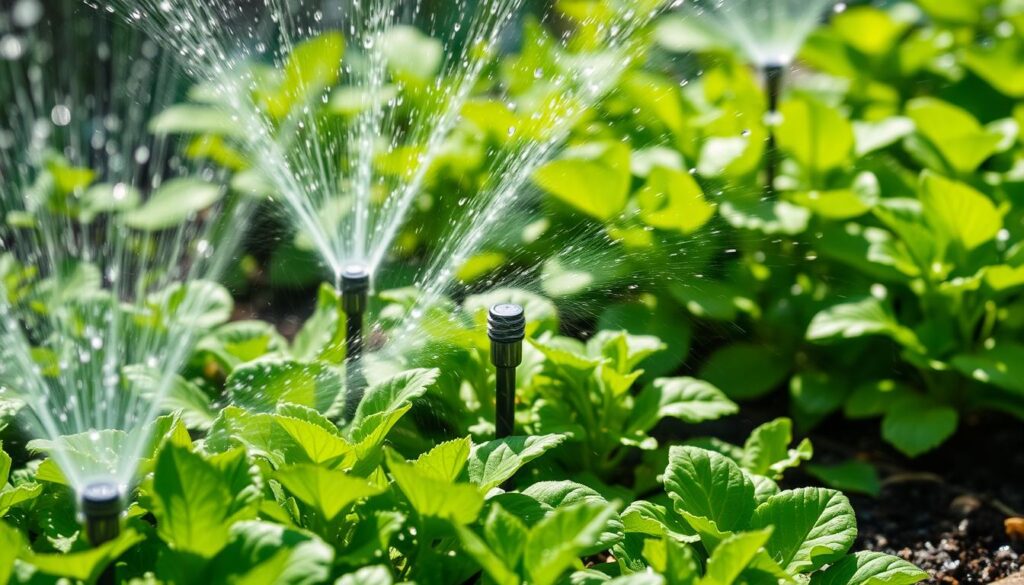
Terracotta Plant Stakes and Olla Watering Systems
Boost your small garden’s watering with terracotta plant stakes and olla watering systems. These methods are simple and sustainable. They keep your plants healthy with consistent moisture.
Terracotta plant stakes, or watering spikes, change the game for potted plants. They slowly release water from a bottle into the soil. This steady moisture helps prevent drought stress and feeds your plants well.
Ollas are unglazed clay pots that release water into the soil. They’re perfect for container gardens and small spaces. Ollas make watering easy and support strong root growth.
Terracotta plant stakes and olla watering systems make watering easy and consistent. They focus on simplicity, sustainability, and consistency. They’re great for small gardeners who want an easy, eco-friendly way to water.
“Watering my plants has never been easier with these terracotta stakes. They keep my potted plants perfectly hydrated without any fuss.”
| Feature | Terracotta Plant Stakes | Olla Watering Systems |
|---|---|---|
| Water Delivery | Slow release from attached bottle | Gradual seepage through porous walls |
| Ideal for | Potted plants | Container gardens, small spaces |
| Maintenance | Refilling attached bottle | Occasional refilling of olla |
| Key Benefits | Consistent moisture, reduced drought stress | Consistent moisture, healthy root growth |
Choose terracotta plant stakes or olla watering systems for a simple, sustainable way to water your garden. These methods are low-maintenance and eco-friendly. Enjoy a lush garden with these easy techniques.
Container Gardening Tips
Creating a lively container garden in small spaces is rewarding. But, it’s important to water your plants well to stop them from drying out too fast. Luckily, there are ways to make sure your plants grow well with little work.
Self-Watering Pots and Grouping Containers
Self-watering pots with built-in reservoirs help you water less often. They slowly release moisture to the roots. Grouping containers together also helps by creating a cooler, more humid space. This slows down evaporation, keeping the soil moist for longer.
Saucers and Bottom-Up Watering
Using saucers or trays under your pots allows for bottom-up watering. This lets the roots soak up moisture from the bottom. It’s great for keeping plants hydrated in hot, dry weather. Just remember to empty the saucers to avoid waterlogging.
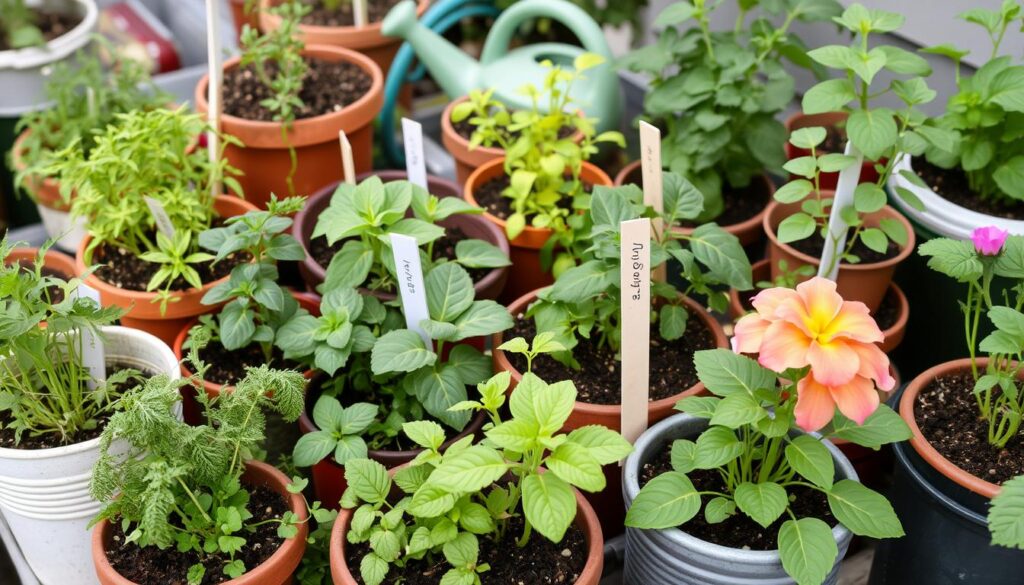
“Keeping the soil consistently moist is crucial for your container plants’ health and beauty. By using these easy tips, you can keep your garden looking great with little effort.”
These tips are great for anyone growing herbs, veggies, or flowers in containers. They ensure your plants get enough water to thrive, even in small outdoor areas.
Conclusion
Keeping a small garden lush and healthy doesn’t have to be hard. By using smart watering methods, like soaker hoses and drip systems, you can make sure your plants get enough water easily. These techniques save water and help plants stay healthy for a long time. This lets you enjoy a beautiful garden with less work.
These watering tips work well for raised beds, in-ground gardens, or containers. They help you create a lovely, easy-care garden that looks great all season. By focusing on saving water and meeting your garden’s needs, you can have a lively outdoor area that’s easy to maintain but full of life.
So, check out the watering tips in this article and pick what fits your gardening style and easy-care needs. With some planning and the right methods, your small garden can become a peaceful spot of beauty and plenty, without the hard work of keeping it up.
FAQ
What are the benefits of proper watering techniques for small gardens?
Proper watering helps prevent drought and overwatering. It keeps plants healthy and growing well. This leads to strong roots, better photosynthesis, and plants reaching their full potential.
How can soaker hoses help keep my small garden hydrated?
Soaker hoses release water slowly into the soil. This keeps the soil moist without wasting water. They work great for raised beds and in-ground gardens, giving plants the water they need right at their roots.
What are the advantages of using a drip irrigation system in my small garden?
Drip irrigation systems send water straight to each plant’s roots. This is done through tubes and emitters. It’s a precise and efficient way to water, and it can grow with your garden.
How can hand watering be an effective technique for small gardens?
Hand watering lets you control where the water goes and adjust the flow. Using the right tools, like a watering can or a hose with an adjustable nozzle, makes it a personal and effective method.
What are some specific watering techniques for different small garden setups?
For raised beds, soaker hoses and drip systems work well. In-ground gardens benefit from sprinklers, mulching, and rain barrels. It’s important to match your watering to your garden’s needs for best results.
How can sprinklers be useful for watering large areas in a small garden?
There are many types of sprinklers for covering big areas easily. For example, a tripod sprinkler connects to your hose and waters specific areas well with little effort.
What are the benefits of using terracotta plant stakes and olla watering systems in small gardens?
Terracotta stakes and olla systems are simple and sustainable. They slowly release water into the soil, giving plants steady moisture. These ancient methods help your plants stay hydrated.
How can I keep my container plants thriving in a small garden?
Use self-watering pots with built-in reservoirs for less watering. Grouping containers together helps reduce evaporation. And, placing saucers under pots allows for watering from the bottom, ensuring roots get enough moisture.
Source Links
- Lazy Girl Watering Essentials: Effortless Techniques for a Thriving Garden – https://www.thetatteredpew.com/lazy-girl-watering-essentials-effortless-techniques-for-a-thriving-garden/
- 13 Tips for Watering Your Garden in Summer – Garden Design – https://www.gardendesign.com/how-to/summer-watering.html
- 10 Ways to Help Your Plants Thrive This Summer: A Comprehensive Guide – https://www.hoselink.com/blogs/gardening-blogs-usa/10-ways-to-help-your-plants-thrive-this-summer-a-comprehensive-guide?srsltid=AfmBOoomaFoX_WQnM5D-_ZsOMlH1FDZ441fp4MWsYgUSBqRNVcXAlIG1
Small Border Plants for Landscaping: Adding Beauty and Functionality to Your Garden
Picture a garden that wows with bright colors, interesting textures, and a perfect mix of beauty and use. You can make this dream a reality with small border plants. These plants are small but powerful, turning simple garden edges into stunning spots. They make your garden look better and work harder.
So, why are these small plants so charming? How do they make your garden more beautiful and useful? Let’s explore the world of small border plants. We’ll find out how to make your garden enchanting and fun.
Key Takeaways
- Small border plants offer a harmonious blend of beauty and functionality for your garden
- These low-growing plants come in a variety of vibrant colors, textures, and growth habits to suit different garden conditions
- Discover the practical benefits of using small border plants, such as low maintenance, drought-tolerance, and versatility in garden designs
- Explore a diverse selection of small border plants, including Sedum, Thymus, Geranium, and more, to elevate the aesthetic appeal of your outdoor space
- Learn how small border plants can create visual interest, texture, and movement in your garden, complementing larger plants and features
Introducing Small Border Plants: Enhancing Your Garden’s Beauty and Functionality
Low-growing plants are perfect for making your garden borders look great and work well. These plants grow close to the ground and have many benefits. They make your garden look better and work better too.
Exploring the Benefits of Low-Growing Plants for Border Designs
Plants like ground cover, dwarf shrubs, and perennial edging are easy to care for. They don’t need much pruning. These plants keep weeds away, letting your garden’s main features stand out.
They also make sure you can see everything clearly. This draws your eye to the big, eye-catching parts of your garden.
Versatility, Adaptability, and Ease of Maintenance
Low-growing border plants come in many textures, colors, and patterns. They can be flowers or evergreen leaves. This means you can change up your garden’s look all the time.
These plants are also very flexible. They grow well in different soils and weather. They help keep the soil in place, stop erosion, and keep moisture in. This makes them great for any garden size or climate.
“Incorporating low-growing border plants into your garden design is a brilliant way to enhance both the beauty and functionality of your outdoor space.”
Top Picks for Vibrant and Textured Border Plants
Creating a beautiful and useful garden border is easy with many options. But, some plants stand out for their unique qualities. Sedum and creeping thyme are two top choices that can make your garden look great.
Sedum (Stonecrop): Succulent Foliage with Star-Shaped Blooms
Sedum, also known as Stonecrop, is a great choice for gardens. It’s tough and can handle dry conditions. These plants come in many colors, shapes, and sizes, from low-growing mats to tall plants.
Their star-shaped flowers come in yellow, pink, and red. They add a bright touch to your garden. Sedum border plants are great for dry gardens and rock gardens. They look good all year, even in fall and winter.
Thymus serpyllum (Creeping Thyme): Fragrant Carpet of Purple Flowers
Thymus serpyllum, or Creeping Thyme, is another great option for borders. It grows low and spreads out, forming a fragrant purple flower carpet. Bees and other pollinators love it.
It’s tough and can handle a lot of foot traffic. That makes it perfect for paths and between stones. Its ability to survive dry conditions and versatility make it a top choice for creeping thyme border plants.
Geranium sanguineum: Adding Pops of Bright Magenta
If you’re looking for a border plant that pops with color, Geranium sanguineum, or Bloody Cranesbill, is perfect. It’s a hardy perennial with bright magenta flowers that bloom from late spring to early summer. These flowers create a stunning display that will catch the eye and delight everyone.
This plant is not just pretty; it’s also practical. Its foliage turns a rich red in the fall, adding interest all year. Plus, it’s deer-resistant, making it great for gardens with deer issues.
Geranium sanguineum is great for ground cover too. It spreads quickly and fills gaps, creating a vibrant carpet along borders. It’s easy to care for, making it a reliable choice for any garden.
“The bright magenta flowers of Geranium sanguineum are a true delight, adding a burst of color that instantly livens up any garden border.”
Looking to make your garden stand out or need a deer-resistant plant? Geranium sanguineum is a top pick. It’s versatile, tough, and adds a splash of magenta magic to any garden.
Ornamental Grasses for Movement and Texture
Make your garden borders more beautiful and useful with ornamental grasses. These plants bring movement and texture that change your landscape. The Hakonechloa macra, or Japanese Forest Grass, is a great choice.
Hakonechloa macra: Cascading Arches of Green
The Hakonechloa macra, or Japanese Forest Grass, is elegant and loves shade. Its leaves arch and cascade, moving in the wind. This grass is great for softening garden edges and adding flow to shady spots.
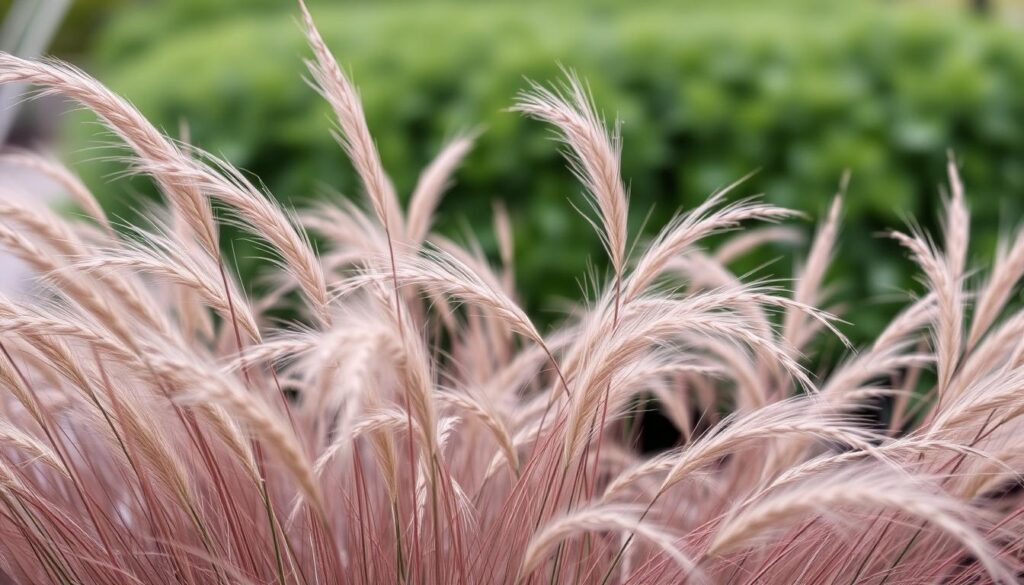
This grass is perfect for adding movement and texture to your garden. It does well in partial shade, making it a smart choice for your garden. Use this grass to make your outdoor areas look better.
“The Hakonechloa macra’s cascading arches of green foliage add a touch of elegance and movement that truly sets your garden apart.”
Small Border Plants for Landscaping: Floral Accents and Fragrance
Creating beautiful garden borders is easy with small, fragrant plants. Dianthus (Pinks) and nepeta (Catmint) are great choices. They bring visual interest and lovely scents to your garden.
Dianthus (Pinks): Sweet-Scented Blooms in Shades of Pink and Red
Dianthus, or Pinks, have fragrant flowers in pink and red. They have slender stems and blue-green leaves. These plants bloom in late spring or early summer, filling the air with sweet smells.
Their flowers last a long time and attract butterflies. They’re perfect for cottage gardens and places that help pollinators.
Nepeta (Catmint): Long-Blooming Lavender-Blue Spikes
Nepeta, or Catmint, has lavender-blue flowers and smells great. It blooms for a long time in summer. This plant is tough and doesn’t need much water.
It’s also a favorite of bees and butterflies. It’s great for borders that love fragrance and help pollinators.
“Fragrant border plants like dianthus and nepeta add an extra layer of sensory delight to any garden, inviting you to slow down and savor the beauty of the landscape.”
Textural Contrasts with Unique Foliage
Designing a beautiful garden border is all about textures and foliage. Stachys byzantina (Lamb’s Ear) and Alchemilla mollis (Lady’s Mantle) are two plants with unique foliage. They make your garden stand out.
Stachys byzantina (Lamb’s Ear): Velvety Silver Leaves
Lamb’s Ear is loved for its soft, fuzzy leaves in silver. These leaves contrast well with other plants and feel nice to touch. In summer, it blooms with small purple flowers, adding color to your border.
This plant is tough and doesn’t need much care. It’s also deer-resistant, perfect for easy-care gardens.
Alchemilla mollis (Lady’s Mantle): Dewdrop-Catching Foliage
Alchemilla mollis, or Lady’s Mantle, has leaves that catch dewdrops. This makes the leaves sparkle in the morning. The plant also has chartreuse flowers that add to its beauty.
It’s easy to grow and can handle different soils and drought. It’s a great choice for adding beauty to your garden.
Adding these plants to your garden creates a beautiful contrast. They add depth and charm to your outdoor space.
Heuchera (Coral Bells): Colorful Foliage and Bell-Shaped Blooms
Make your garden stand out with heuchera, also known as coral bells. These perennials have evergreen leaves in many colors, like deep burgundy and bright chartreuse. They also have delicate, bell-shaped flowers that add beauty to your garden.
Heuchera grows well in both shady and sunny gardens. It’s perfect for adding color and texture. Plus, it attracts hummingbirds, making your garden more lively.
Adding coral bells to your garden creates a beautiful look. It works well with other shade-tolerant border plants and hummingbird-attracting border plants. Let heuchera’s beauty enhance your outdoor space.
“Heuchera’s vibrant color and delicate flowers make it a must-have for any border or garden bed.”
Diverse Color Palette
Heuchera is known for its wide range of foliage colors. You can choose from bold, dramatic shades or more subtle tones. Colors include deep purple, bright lime green, and sunny yellow, adding a pop of color to your garden.
Find the perfect heuchera to match your garden’s look or as a focal point.
Lavandula (Lavender): Fragrant and Drought-Tolerant
Lavender is famous for its lovely smell and bright purple flowers. It’s a great choice for any garden border. This tough plant can handle dry conditions and attracts pollinators, making it good for the environment.
Lavender is perfect for lavender border plants, fragrant border plants, drought-tolerant border plants, and pollinator-friendly border plants. It’s great for gardens that want to smell nice and need plants that can handle the heat and dryness. Lavender is a top pick for gardeners.
Lavender is not just pretty; it has many uses. You can use its essential oils for health or add it to food. It’s a plant that gives back in many ways.
Cultivating Lavender in Your Garden
Here are some tips for growing lavender:
- Choose a spot that gets lots of sun and has soil that drains well.
- Plant lavender in spring or fall, leaving about 12-18 inches between each plant.
- Keep the plants tidy by pruning them often. This helps them grow bushy and promotes new flowers.
- Water them just enough, as lavender likes dry conditions.
Adding lavender to your garden brings beauty and ease. Its lovely scent, bright colors, and toughness make it a favorite. Let lavender be a key part of your lavender border plants, fragrant border plants, drought-tolerant border plants, and pollinator-friendly border plants.
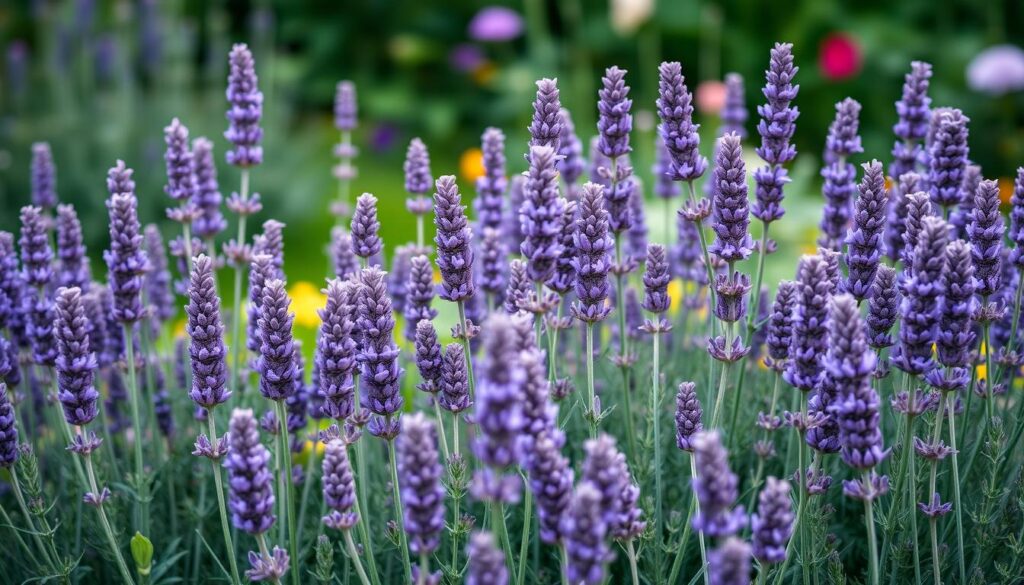
Conclusion: Embracing the Beauty and Functionality of Small Border Plants
Small border plants can make your garden look better and work harder. They are easy to care for and help keep weeds away. They also make your garden look more inviting and give you many design options.
These plants come in many types, like succulents and lavender. Each one adds beauty and practical benefits to your garden. By choosing the right small border plants, you can make your garden stand out and feel more complete.
Small border plants are great for any garden. They are easy to take care of and add beauty and interest. By using them, you can make your garden look amazing and feel welcoming. Start using small border plants to make your garden the best it can be.
FAQ
What are the benefits of using low-growing plants for garden borders?
Low-growing plants make garden borders easy to maintain and keep weeds away. They let you see everything clearly and add different textures, colors, and flowers. These plants also help keep the soil stable, prevent erosion, and keep moisture in.
What are some of the best small decorative plants for landscaping borders?
Great small border plants include Sedum (Stonecrop), Thymus serpyllum (Creeping Thyme), and Geranium sanguineum (Bloody Cranesbill). Other top picks are Hakonechloa macra (Japanese Forest Grass), Dianthus (Pinks), Nepeta (Catmint), Stachys byzantina (Lamb’s Ear), Alchemilla mollis (Lady’s Mantle), and Heuchera (Coral Bells).
How do Sedum and Creeping Thyme contribute to garden borders?
Sedum has thick leaves that store water, blooming in summer and fall. Creeping Thyme has small, fragrant leaves and tiny purple flowers. Both are great for dry areas and add beauty to garden borders.
What are the unique features of Geranium sanguineum?
Geranium sanguineum, or Bloody Cranesbill, has bright magenta flowers and attractive foliage that turns red in fall. It’s tough, versatile, and blooms from late spring to early summer, perfect for garden borders.
How can ornamental grasses enhance garden borders?
Ornamental grasses like Hakonechloa macra add movement and texture to borders. Their flowing foliage in green or variegated stripes moves in the breeze, softening edges and adding a natural beauty to the landscape.
What other floral accents can be used in garden borders?
Other great floral accents include Dianthus (Pinks) for their scent and Nepeta (Catmint) for its lavender-blue flowers and grey-green leaves. These plants attract butterflies and bloom for a long time, making borders more appealing.
What plants offer unique foliage for garden borders?
Stachys byzantina (Lamb’s Ear) has soft, silver leaves and Alchemilla mollis (Lady’s Mantle) has leaves that collect dew. These plants add contrast and interest to garden borders.
How can Heuchera and Lavender contribute to garden borders?
Heuchera, or Coral Bells, has colorful leaves and small, bell-shaped flowers that attract hummingbirds. Lavender is known for its scent and purple flowers, and it’s very drought-tolerant, attracting pollinators.
Source Links
- 10 Small Plants for Landscaping – https://www.familyhandyman.com/list/small-plants-for-landscaping/
- Top 10 Low Growing Plants for Garden Borders — Meadowlark Journal – https://meadowlarkjournal.com/blog/low-growing-plants-for-borders
- Border Plants – https://plantsbymail.com/collections/border-plants?srsltid=AfmBOoo7qNYF2qpZZm2Hc21BU-VwmDmcEOBt3XdU-gs3VlS6vepYjj9N
Year-Round Small Space Gardening: Seasonal Planting Tips for Maximum Harvest
Do you dream of a garden that’s always full of life, but you don’t have much space? Imagine picking fresh veggies all year, even in tiny spots or inside your home. The key to this is learning how to plant at the right times to make the most of your space. With the right approach, you can turn a small area into a place full of tasty and healthy food.
Key Takeaways
- Discover how to extend your harvest season and enjoy fresh produce year-round
- Learn practical techniques to overcome common challenges of small-space gardening
- Develop a comprehensive plan to maximize your limited growing area
- Implement a 15-minute daily routine to maintain a thriving year-round garden
- Explore the benefits of succession planting and crop rotation for continuous harvests
Embracing Year-Round Gardening
Year-round gardening might seem tough, but it lets you enjoy a long harvest season beyond summer. With the right methods and a solid plan, your small space can become a lively year-round gardening spot.
Extending the Harvest Season
Year-round gardening lets you keep your harvest going. Using succession planting and crop rotation means you get fresh produce all year. This doesn’t mean more work, though.
- Succession planting means planting seeds or moving plants often. This way, you get a steady supply of different crops.
- Crop rotation keeps the soil healthy and stops pests and diseases from taking over, making your garden last longer.
Overcoming Misconceptions and Hesitations
Some gardeners don’t want to garden all year, thinking the seasons have their reasons and a break is needed. But, this idea can be changed by seeing the perks of a extended harvest season and the ways to achieve it.
“With the right approach, you can create a deeper connection to nature and your garden’s ecosystem while reaping the benefits of a bountiful, year-round harvest.”
Thinking about year-round gardening lets you have a garden that always gives and a closer connection to nature.
Five Keys to Year-Round Gardening Success
Want to make your garden bloom all year? It’s all about having a solid plan and sticking to it. Follow these five key tips to keep your garden thriving season after season.
Having a Comprehensive Plan
Start by making a detailed gardening plan. It should cover your planting schedule, keep track of important tasks, and help you fix any problems. Mix planning with flexibility to fit your garden’s unique needs.
Maintaining Consistency: 15 Minutes a Day
Being consistent is crucial in gardening. Spend just 15 minutes each day checking on your garden. This keeps you on track and makes gardening enjoyable, not just a chore.
- Set aside a few minutes daily to care for your plants.
- Keep a garden journal to note your progress and ideas.
- Regularly check and tweak your gardening plan as needed.
By using these five tips, you’ll be on your way to a fruitful and satisfying year-round garden, even with limited space.
“The key to a thriving garden is not just what you plant, but how consistently you tend to it.” – Jane Doe, Gardening Enthusiast
Monthly Gardening Guides
Gardening all year can be rewarding but also complex. Having a monthly gardening guide can change the game. These guides offer a roadmap for seasonal gardening tasks and preparations.
Knowing your garden’s yearly rhythm helps you plan better. You can plan, organize, and increase your harvests. These guides tell you the best times for planting, pruning, and harvesting. They give insights to keep you ahead in gardening.
- Identify the most demanding months in the garden and plan accordingly.
- Discover when you’ll have the time to strategize and get organized for the upcoming seasons.
- Ensure you have the necessary materials and equipment on hand for each month’s tasks.
- Avoid missing out on valuable harvests by understanding the seasonal ebb and flow of your garden.
Using monthly gardening guides can unlock your small-space garden’s full potential. By following these guides, you can plan, prepare, and succeed in every season.
Applying the 80/20 Rule
As a gardener, it’s easy to get caught up in the many tasks needed to keep your garden healthy. But, using the 80/20 rule can help you focus on the most important tasks. These tasks are the ones that give you 80% of the results for a great garden.
Focusing on Essential Tasks
Identifying key tasks like cutting dead plants, adding soil amendments, and mulching is crucial. This way, you can keep your garden in top shape without feeling overwhelmed. By focusing on these essential tasks, you can use your time and energy more wisely. This leads to a more rewarding gardening experience.
- Cut back dead plant material to encourage new growth
- Add organic matter, such as compost or aged manure, to improve soil quality
- Apply a fresh layer of mulch to suppress weeds and retain moisture
- Prune and shape plants as needed to maintain their health and appearance
- Monitor for pests and diseases, addressing issues promptly
The secret to great gardening isn’t doing everything. It’s focusing on the tasks that make the biggest difference. By using the 80/20 rule, you can have a beautiful garden with less work and more fun.
| Task | Frequency | Impact |
|---|---|---|
| Cutting back dead plant material | Monthly | High |
| Adding soil amendments | Seasonally | High |
| Mulching | Annually | High |
| Pruning and shaping plants | As needed | Moderate |
| Pest and disease monitoring | Weekly | Moderate |
Remembering Your Gardening Motivation
As a gardener, it’s key to recall why you began growing your own plants. Gardening motivation comes from many places. Keeping in touch with your personal “why” keeps you motivated, even when it gets tough.
Maybe you started gardening for a break from the hustle and bustle, to eat better, or to teach a young one new skills. Or perhaps your aim was to live more independently, connect with nature, or get more active. Whatever your reason for gardening, thinking about it can give you the push you need to keep up.
“Gardening is a way to ground ourselves, to connect with the earth and the seasons, and to nurture life. It’s a powerful way to find peace and joy, even in the most chaotic of times.”
When the weather doesn’t cooperate, pests are a problem, or the work seems too much, think back to your reasons for gardening. Remembering your “why” helps you keep going. It makes the process enjoyable, not just the results.
Take a moment to think about what drives you to garden. Write down your main reasons and look at them when you need motivation. Staying connected to your gardening motivation keeps your passion alive and brings you the many rewards of this hobby.
Year-round small space gardening
Gardening in small spaces needs careful planning and smart plant choices. Don’t pick big, spreading plants like pumpkins and squash. They take up too much space. Instead, go for compact veggies and herbs that do well in containers.
Choosing Plants Wisely
Look for plants labeled as “determinate,” “compact,” or “short stature” for your small garden. These plants won’t get too big, letting you grow more in a small area. With the right plants, you can fill even tiny spaces with a lush, productive garden.
Utilizing Containers
Containers are key for small gardens. They let you grow plants in tight spots like balconies or patios. By picking the right containers and placing them well, you can make the most of your space and enjoy fresh produce all year.
| Container Size | Suitable Plants |
|---|---|
| 5-gallon Pot | Tomatoes, peppers, eggplants, bush beans, radishes, lettuce |
| 2-gallon Pot | Herbs, cherry tomatoes, dwarf or compact vegetables |
| 1-gallon Pot | Herbs, microgreens, small edible flowers |
Follow these tips for small space gardening and container use. You can have a thriving garden in even the smallest spaces. With creativity and planning, your small garden can be a year-round source of fresh produce.
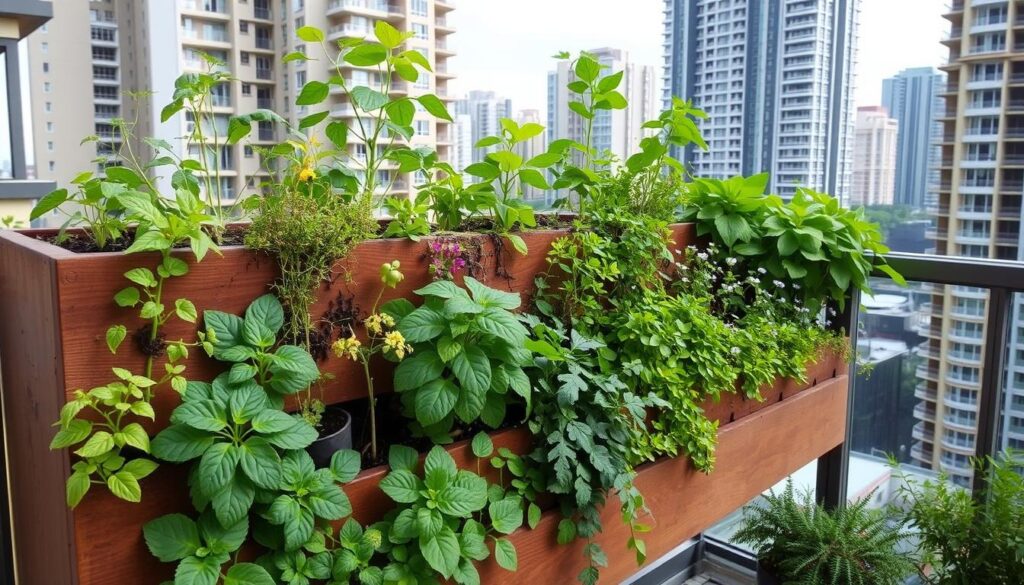
“Gardening in containers allows you to maximize your limited space while still enjoying the benefits of homegrown produce.”
Succession Planting for Continuous Harvests
In small-space gardening, succession planting changes the game. It lets you have fresh produce all season long, making the most of your garden space. By planting crops like lettuce, radishes, and peas every few weeks, you get a steady harvest, not just one big batch.
Knowing when your favorite vegetables grow best is key to success. Quick-growing greens and root veggies are great for this method. Plant new batches every two to three weeks for a constant supply of fresh food.
- Lettuce: Plant a new row every 2-3 weeks for a steady stream of salad greens.
- Radishes: Sow seeds in succession every 10-14 days for a continuous harvest.
- Peas: Sow a new crop every 3-4 weeks for a prolonged pea season.
Learning succession planting boosts your small garden’s productivity. Enjoy fresh produce all season with this technique. It’s a way to have your own continuous harvests at home.
“Succession planting is the secret to maintaining a lush, bountiful garden in limited space. It’s like having your own personal farmer’s market right outside your door.”
Crop Rotation in Small Spaces
For small-space gardeners, crop rotation might seem hard, but it’s key for a healthy garden. It helps reduce diseases, adds nutrients to the soil, and keeps your garden alive all year.
Rotating Plant Families
Grouping plants by family and rotating them is a smart move for small gardens. Put brassicas like kale and broccoli in one spot, and cucurbits and solanaceous crops in others. This stops pests and diseases from spreading easily.
Raised Bed Gardening
Raised beds make crop rotation simpler in small gardens. They let you keep track of where each crop is. This way, you can manage soil and pests better in each bed, not the whole garden at once.
| Crop Rotation Benefits | Raised Bed Gardening Benefits |
|---|---|
|
|
Using crop rotation and raised beds, small-space gardeners can have healthier soil and fewer pests. This leads to a bigger and more successful harvest all year.

Maximizing Limited Growing Areas
Gardening in small spaces is a fun challenge that needs creativity and planning. By using maximizing small space and small space gardening techniques, you can turn tiny areas into a lush garden full of fresh food and beautiful plants.
Think about using vertical gardening to make the most of your space. Use trellises, towers, or hanging baskets to grow more plants. This saves ground space and lets you grow a variety of plants, like climbing vines and trailing herbs.
- Use vertical structures for climbing veggies like tomatoes, cucumbers, or pole beans.
- Hang baskets or stack planters for trailing plants like strawberries or cascading flowers.
- Try tiered or raised garden beds to use more space.
Container gardening is another great way to garden in small spaces. Use pots, planters, and even old items to start a mini-garden. Pick compact or dwarf plants to grow more in a small area.
Consider succession planting to get more from your garden. Plan when to plant different crops to keep harvesting from the same spot. This way, your garden stays productive all season, even in a small space.
“With a little creativity and strategic planning, even the most limited growing areas can become a thriving oasis of fresh produce and vibrant flora.”
Using these small space gardening techniques, you can make your garden full of life and fresh food all year.
Conclusion
Year-round small space gardening is possible and can be very rewarding. It brings joy and lots of fresh produce to gardeners at all levels. With a good plan, regular care, and methods like succession planting and crop rotation, you can have a steady harvest. This way, you stay connected to your garden all year, even in small spaces.
Keep your gardening motivation strong to stay inspired. Feel free to try new things and see what suits your garden best. With the right strategy, you can make the most of your small space and enjoy a garden that thrives all year.
For both experienced and new gardeners, the secrets to a successful year-round garden are easy to find. Take pleasure in your progress and the fruits of your hard work. Your garden is waiting for you!
FAQ
What are the key benefits of year-round small space gardening?
Year-round gardening lets you harvest all 12 months. It deepens your connection to nature and your garden. Plus, you get to enjoy harvests without a big increase in work.
How can I overcome common misconceptions about year-round gardening?
Realize that seasons don’t just happen by chance. You don’t always need a winter break. With the right strategy, you can have harvests all year.
What are the essential steps to achieving year-round gardening success?
For year-round gardening, make a detailed plan. Stick to it consistently, even with just 15 minutes a day. Understand your garden’s work flow throughout the year.
How can monthly gardening guides help me in my year-round gardening efforts?
Monthly guides offer key info. They tell you which months are busiest and when you can plan and organize. They also list materials and equipment you need and what harvests you might miss during vacations.
How can I focus my energy on the most essential gardening tasks?
Use the 80/20 rule to find the 20% of tasks that give you 80% of the results. This way, your garden will thrive without feeling overwhelmed by too many tasks.
How can remembering my personal gardening motivation help me stay inspired?
Keep in mind why you started gardening. It could be for peace, health, learning with a kid, self-sufficiency, nature connection, or exercise. These reasons can keep you going, even when it’s tough.
What are some tips for gardening in limited spaces?
In small spaces, choose compact veggies and herbs. Use containers smartly. Try vertical gardening and succession planting to get the most from your space.
How can succession planting help me enjoy continuous harvests?
Succession planting means planting crops like lettuce, radishes, and peas every few weeks. This way, you get a steady harvest instead of one big batch, making the most of your space.
How can crop rotation benefit my small-space garden?
Crop rotation in small gardens fights diseases and keeps soil healthy. Group plants by type and move them around your garden or containers. This way, you get the most from your space.
Source Links
- Gardening in small spaces – https://extension.umn.edu/yard-and-garden-news/gardening-small-spaces
- Year-Round Gardening: It’s Easier Than You Think – https://www.tenthacrefarm.com/year-round-gardening/
- All year round vegetable sowing and planting guide – https://steves.seasidelife.com/2020/01/18/all-year-round-vegetable-sowing-planting-guide/
Essential Tools for Small-Space Gardening: What You Really Need
Small-space gardening, whether in containers, urban areas, or indoor hydroponics, needs the right tools. These tools can turn a small area into a lush oasis. But what are the must-haves for the smart small-space gardener? Find out the key gardening tools that boost your green thumb skills and make the most of your small space.
Key Takeaways
- Investing in quality gardening tools is crucial for successful small-space gardening
- Versatile hand tools like trowels, pruners, and hoes are essential for planting, trimming, and weed control
- Proper soil preparation and cultivation tools, such as garden spades, can help you create the perfect growing environment
- Mobility and storage solutions, like wheelbarrows and tool organization systems, can streamline your gardening tasks
- Choosing durable, long-lasting tools will ensure your small-space garden thrives for years to come
Are you ready to turn your small outdoor or indoor space into a blooming oasis? Discover the essential tools that will empower your small-space gardening dreams and unlock your full green-thumb potential.
Introduction to Small-Space Gardening
Gardening in small spaces like balconies, patios, or windowsills has many benefits. You can grow your own food, herbs, and flowers in tight spots. It’s a hobby that’s both relaxing and fulfilling, connecting you to nature and giving you a sense of pride.
Benefits of Gardening in Small Spaces
Small-space gardening lets you enjoy the perks of container gardening, urban gardening, and vertical gardening. These methods help you make the most of small areas, turning them into lush gardens.
- Grow your own fresh, organic produce and herbs right at home
- Enhance the aesthetic appeal of your living space with beautiful flowers and foliage
- Reduce your carbon footprint by minimizing the need for transportation and packaging
- Enjoy a rewarding hobby that promotes relaxation and stress relief
- Attract beneficial pollinators, such as bees and butterflies, to your urban oasis
Challenges of Limited Space and Solutions
Small-space gardening has its perks but also faces unique hurdles. The limited space can make it hard to fit all the plants you want. Plus, small areas often get less sunlight and can suffer from soil compaction.
To beat these hurdles, gardeners use vertical gardening, hanging baskets, and trellises. Growing plants in container gardens and raised beds also helps. Choosing compact, efficient tools can make a small garden more productive.
“Gardening is a way to unleash your creativity and transform even the smallest of spaces into a thriving oasis.”
Must-Have Hand Tools for Small Gardens
For small-space gardening, having the right hand tools is key. You’ll want a hand trowel and pruners in your gardening kit.
Hand Trowel – Versatile for Planting, Transplanting, and Weeding
A hand trowel is a must for small-space gardeners. It’s great for planting, transplanting, potting, weeding, and loosening hard soil. Choose one with a strong handle and a long-lasting, stainless steel blade.
Pruners – Essential for Trimming and Plant Maintenance
Pruners, or secateurs, are vital for small gardens. They trim dead or overgrown parts of plants. Bypass pruners are best for live plants and green wood. Anvil pruners work better on deadwood. Pick pruners with a good grip and ratcheting action for more power.
“Having the right tools can make all the difference in small-space gardening. A quality hand trowel and pruners are must-haves for any gardener looking to keep their plants healthy and thriving.”
Soil Preparation and Cultivation Tools
Gardening in small spaces needs a smart plan for soil and cultivation. A key tool for this is the garden hoe. It’s great for many tasks, like making beds ready for planting or getting rid of weeds.
Garden Hoe – Ideal for Preparing Beds and Removing Weeds
A garden hoe has a flat, wide edge and a long handle. It’s a must-have for small gardens. With it, you can till the soil, tidy up lawn edges, break up hard earth, and weed out unwanted plants. Choose a hoe that’s light, has a sharp edge, and a strong handle. The Dutch hoe is a top pick for small gardens because of its unique triangular blade.
| Tool | Key Features | Best Use |
|---|---|---|
| Garden Hoe |
|
|
The garden hoe is a powerhouse for small gardens. It makes keeping your garden healthy and neat easy. Get a good hoe, and you’ll find preparing soil and controlling weeds a breeze in your small garden.
Digging and Planting Tools
For small-space gardening, having the right tools is key. The garden spade is a must-have. It’s great for digging holes, defining garden edges, and dividing plants. It even helps with creating trenches.
The Versatile Garden Spade
Choose a garden spade with a stainless steel blade for clean cuts and an ergonomic handle for comfort. This tool helps break up hard soil, making planting easier.
The garden spade is also perfect for dividing plants. It’s great for separating overgrown perennials or creating new plants. With a few strokes, you can divide roots and move plants around your garden.
In small gardens, the garden spade is a big help. It’s small and easy to move, perfect for tight spaces and raised beds. You can dig exactly where you need to without taking up too much space.

“A good garden spade is an essential tool for any small-space gardener. Its versatility and compact design make it a must-have for tasks ranging from planting to dividing plants.”
The garden spade is a must-have for digging and planting in small gardens. It’s powerful, precise, and easy to move. This makes it a great tool for making the most of your garden space.
Rakes and Cleanup Tools
Keeping a small garden tidy is key. The garden rake is a must-have for this. It helps remove leaves, twigs, and other debris from your lawn and garden beds. This keeps your garden looking neat and clean.
Rakes do more than just clean. They can also loosen hard soil and even out uneven ground. This makes it ready for new plants or a fresh lawn cut. When picking a rake, think about what your garden needs. A bow rake is great for hard soils, and a fan rake is perfect for leaves.
Choosing a top-notch garden rake changes the game in lawn cleanup. It makes keeping your small garden spotless easy. With the right rake, you can keep your garden looking great without the hard work of picking up debris. A well-kept garden brings joy and pride, and the right rake makes it look effortless.
“A garden is a grand teacher. It teaches patience and careful watchfulness; it teaches industry and thrift; above all it teaches entire trust.”
– Gertrude Jekyll
Tools for small-space gardening
When you’re gardening in tight spots, the right tools are key. Tools like compact garden forks and shovels help you work smarter, not harder. They let you keep your garden looking great, even in small spaces.
Compact Garden Forks and Shovels
Big garden tools can be hard to use in small gardens. That’s where compact garden forks and garden shovels come in handy. They’re smaller and lighter, ideal for digging and mixing soil in tight spots. Look for tools with short handles that are easy to handle and store.
Weeders for Efficient Weed Control
Weeds can quickly take over a garden. Garden weeders help you fight back. Manual weeders work like a small hoe to remove weeds. Mechanical weeders grab weeds by the roots for easy removal. A good weed control tool is key for a neat and productive small-space garden.
“The right tools can make all the difference in a small garden, transforming a laborious task into an efficient and enjoyable one.”
Watering Tools for Small Spaces
Getting the right amount of water is key for small-space gardens. Good watering tools make the job easier and more accurate. This leads to healthier plants and a lively garden, even in tight spots.
Watering Cans and Wands for Precise Watering
Watering cans come in plastic or metal and let you water plants without jarring the soil. Choose cans with comfy handles and spouts for a steady flow. Watering wands reach far and have adjustable sprays, perfect for tricky spots and fragile plants. They help you water your small garden just right.
| Watering Cans | Watering Wands |
|---|---|
| Gentle, even flow | Extended reach |
| Comfortable handles | Adjustable spray patterns |
| Plastic or metal options | Ideal for hard-to-reach areas |
Choosing a watering can or a watering wand is crucial. These tools help keep your small garden moist and healthy.
“Proper watering is the key to a thriving small-space garden. With the right tools, you can ensure your plants receive the precise amount of water they need, even in the tightest of spaces.”
Protective Gear for Gardeners
Gardening is a rewarding hobby but can be hard on your hands. That’s why getting a good pair of garden gloves is key for gardeners. They should be tough, yet let your hands breathe, and fit well for easy movement.
Choose gloves with fabrics that don’t let water in and palms and fingers that are extra tough. This helps avoid cuts, scrapes, and blisters. Gloves with longer cuffs also protect your wrists and forearms from scratches and dirt, making sure your hand protection covers more area.
- Durable yet breathable materials for comfort and flexibility
- Water-resistant fabrics to keep your hands dry
- Reinforced palms and fingers for added gardening safety
- Extended cuffs to protect your wrists and forearms
Getting a good pair of garden gloves can really change your gardening. They protect your hands and keep you comfy while you work on your plants and outdoor tasks.
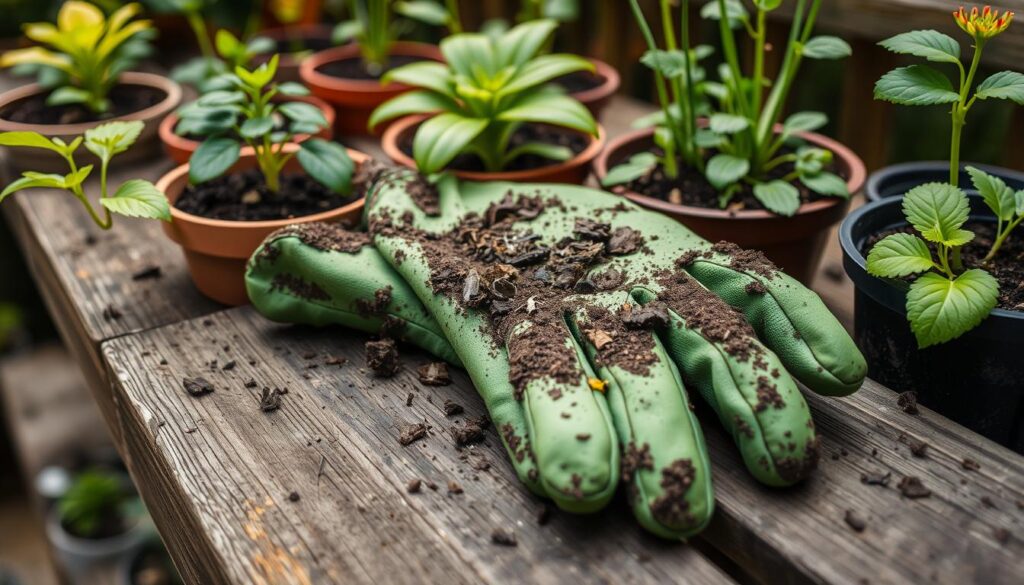
“I’ve tried so many different garden gloves, but these are by far the best. They’re durable, comfortable, and keep my hands safe from scratches and dirt. Highly recommend!”
Mobility and Storage Solutions
In a small garden, moving heavy items like soil or compost can be tough. A strong wheelbarrow or garden cart can make this easier. Single-wheeled wheelbarrows are great for tight spots, while two-wheeled carts are better for heavy loads. Choose ones with sturdy builds and comfy handles to protect your back and arms.
Wheelbarrows and Carts for Easy Transportation
Choosing the right transportation tool is crucial for small-space gardening. Single-wheeled wheelbarrows are super easy to move around. Two-wheeled garden carts are stable and can carry more, like big bags of soil or compost.
Tool Storage and Organization Ideas
Organizing your gardening tools is important in a small-space garden. Think about getting a tool rack or a small storage cabinet. Pegboards and magnetic strips can also help keep your tools tidy. Good tool storage and organization means your tools stay in top shape and are always ready.
With the right mobility and storage solutions, small-space gardening tasks become easier. You’ll keep your workspace neat and efficient.
Choosing Quality Tools for Longevity
When setting up your small-space garden, picking the right tools is key. Tools that are durable and well-made work better and last longer. This saves you money over time. Look for tools with stainless steel blades, comfy handles, and strong parts that can handle daily use.
Choosing tools that last a long time makes gardening easier and more fun. Even though good tools might cost more at first, they pay off later. They help you garden better for years.
- Stainless steel blades for superior durability
- Ergonomic handles for comfortable, fatigue-free use
- Reinforced components to withstand regular use
“Quality is remembered long after the price is forgotten.”
This saying is true for gardening tools too. By focusing on quality, your tools will last longer. This lets you enjoy your garden more.
Conclusion
Starting your small-space gardening journey is exciting. With the right essential gardening tools and creativity, even a tiny area can become a lush oasis. Tools like hand trowels, pruners, hoes, spades, and watering equipment help you make the most of your space. They let you grow your own plants, flowers, and produce.
Choosing quality tools is crucial for your small-space garden‘s success. These tools last long and help you keep your garden thriving. Don’t forget to find smart ways to store and organize your tools. With the right tools and creativity, you can create a beautiful small-space garden that brings you joy and pride.
Use the gardening tips and strategies you’ve learned to let your passion for small-space gardening grow. Your garden is waiting for you. With the right tools and attitude, you can turn it into a haven for your gardening hobbies.
FAQ
What are the essential tools for small-space gardening?
For small-space gardening, you’ll need tools like hand trowels, pruners, hoes, spades, rakes, garden forks, shovels, weeders, garden gloves, and wheelbarrows or carts.
What are the benefits of gardening in small spaces?
Gardening in small spaces lets you grow your own food and flowers. It’s a hobby that’s relaxing and rewarding. It connects you to nature and makes you feel accomplished.
How can I overcome the challenges of small-space gardening?
Use vertical gardening and grow plants in containers to overcome small-space gardening challenges. Choose compact tools to save space.
Why is a hand trowel an essential tool for small-space gardening?
A hand trowel is crucial for small-space gardening. It’s great for planting, transplanting, potting, weeding, and breaking up hard soil.
What should I look for when choosing pruners for my small garden?
Look for pruners with a comfortable grip and ratcheting action for more power. Bypass pruners work well on live plants and green wood. Anvil pruners are best for deadwood.
How can a garden hoe help in small-space gardening?
A garden hoe is key for small-space gardening. It has a flat edge and long handle for tilling soil, weeding, and preparing beds.
What makes a garden spade a valuable tool for small-space gardening?
A garden spade is essential for small-space gardening. It’s great for digging holes, defining edges, dividing shrubs, and making trenches.
How can weeders help maintain a tidy small-space garden?
Weeders, manual or mechanical, keep your small-space garden neat. They help remove weeds efficiently, keeping your garden tidy.
Why are garden gloves an important piece of protective gear for small-space gardeners?
Gardening can be hard on your hands. Good garden gloves protect you from cuts and scrapes. They let you move easily too.
How can a wheelbarrow or garden cart be useful in a small-space garden?
Moving heavy items like soil or compost can be hard in a small garden. A wheelbarrow or garden cart makes it easier, saving your back and arms.
Source Links
- 10 Essential Gardening Tools for a Small Garden – https://ecogardener.com/blogs/news/10-essential-garden-tools-for-a-small-garden?srsltid=AfmBOorq0p4UxF98v1yfeuq33oSVhMAuuPw3hOWq8oP3bKBkMP8YtZsq
- 12 Garden Tools to Buy – Essentials for Beginners – Garden Design – https://www.gardendesign.com/how-to/tools.html
- 10 Must-Have Gardening Essentials for When You’re Short on Space – https://www.hgtv.ca/small-space-gardening-essentials/
The Ultimate Guide to Container Vegetables: What to Grow in Small Spaces
Living in a small apartment doesn’t mean you can’t grow your own food. Container gardening lets you grow a garden even in tiny spaces. You can use balconies, patios, windowsills, or rooftops to grow your own food. But, what are the best vegetables for small spaces? Learn how to turn your small area into a garden full of fresh produce.
Key Takeaways
- Container gardening allows you to grow fresh produce in small spaces like balconies, patios, and windowsills.
- Compact vegetable varieties and space-saving techniques can help you maximize your limited growing area.
- Proper container selection, soil preparation, and watering strategies are key to maintaining a healthy and productive container garden.
- Vertical gardening with trellises and hanging planters can help you grow more in less space.
- Choosing the right combination of cool-season and warm-season crops can provide you with a continuous harvest throughout the year.
Benefits of Growing Container Vegetables
Container gardening lets you grow your own food with many benefits. These space-saving vegetables and compact vegetable varieties help you use small spaces well. They turn tiny areas into lively mobile gardens. By controlling your garden, you make sure your plants do well in a controlled growing environment.
Space-saving and Mobility
Container gardens are great for those with little outdoor space. You can grow many vegetables in small containers on a patio, balcony, or even a sunny window ledge. These compact vegetable varieties let you have a big harvest without using a lot of space.
Control over Growing Environment
Container gardening gives you a lot of control over your garden. You can pick the best potting mix for your plants, making sure they get the nutrients they need. You can also adjust things like moisture, sunlight, and temperature to make the best conditions for your space-saving vegetables.
Reduced Weed and Pest Problems
Container gardens have fewer weed and pest problems than gardens in the ground. Your plants don’t touch the soil, so they’re less likely to get infested. This means you can focus more on taking care of your compact vegetable varieties without fighting weeds and pests all the time.
“Container gardening is a game-changer for urban and small-space dwellers who crave fresh, homegrown produce.”
Planning Your Container Garden
Starting a container garden needs careful planning for a successful harvest. First, pick the best spot and the right containers.
Choosing the Right Location
Where you place your container garden is key to its success. Look around your home for spots that get 6-8 hours of sunlight a day. Think about how close it is to water, if it’s sheltered, and easy to reach for upkeep.
Also, consider how much foot traffic it will get and if it’s safe from harsh weather. This will help you find the perfect spot for your garden.
Selecting Suitable Containers
Picking the right containers is vital for healthy plants. Go for materials like plastic, ceramic, or wood that drain well. Make sure they’re big enough for your plants’ roots and fit the size and type of plants you want.
Think about how your containers look to make your garden pretty. This way, you’ll have a garden that looks good and grows well.
| Container Material | Advantages | Disadvantages |
|---|---|---|
| Plastic | Lightweight, durable, inexpensive | May not have the best aesthetic appeal |
| Ceramic | Attractive, good insulation properties | Heavier and more fragile than other options |
| Wooden | Unique and natural appearance, can be custom-built | Susceptible to weathering and rot over time |
Think about the location and the containers you use to create a great container garden. This way, you’ll use your space well and meet your plants’ needs.
Container Vegetables for Small Spaces
Not all vegetables are the same when it comes to container gardening. Focus on compact or dwarf varieties that do well in pots and planters. Great choices include beans, carrots, lettuce, peppers, radishes, spinach, and tomatoes. These container-friendly vegetables are ideal for small gardens and can give you a big harvest from tiny spaces.
Herbs and Leafy Greens
Herbs for containers and leafy greens for containers are also great for small gardens. Herbs like basil, chives, cilantro, mint, parsley, and rosemary do well in containers and add flavor to your cooking. Leafy greens like arugula, kale, and Swiss chard are nutritious and look good in pots or window boxes.
| Vegetable Variety | Container Suitability |
|---|---|
| Beans | Excellent |
| Carrots | Good |
| Lettuce | Excellent |
| Peppers | Excellent |
| Radishes | Excellent |
| Spinach | Good |
| Tomatoes | Good |
Choosing the right compact vegetable varieties, container-friendly vegetables, herbs for containers, and leafy greens for containers lets you have a successful and productive container garden, even in small spaces.
Preparing Containers and Potting Mix
Starting a container garden right means getting ready first. Don’t use regular garden soil because it can pack down and block water flow. Instead, pick a potting mix made just for containers. These mixes have the right mix of nutrients, air, and water to help your plants grow well.
Drainage and Container Materials
Good drainage is key for healthy veggies in containers. Make sure your containers have lots of drainage holes to stop water from pooling and causing root rot. The type of container you use matters too. Think about using plastic, resin, or fabric pots. They’re light, strong, and help keep the roots cool and the soil from getting too heavy.
| Container Material | Advantages | Disadvantages |
|---|---|---|
| Plastic | Lightweight, affordable, durable | Can heat up in direct sunlight |
| Resin | Durable, resists weathering, insulates well | More expensive than plastic |
| Fabric Pots | Excellent drainage, air-pruning roots | May need more frequent watering |
| Terra Cotta | Porous, helps regulate soil moisture | Heavy, can be fragile |
Choosing the right containers and potting mix sets the stage for a great container garden. You’ll get lots of harvest even in small spaces.
“The key to successful container gardening is to choose the right potting mix and ensure proper drainage. This sets the stage for your plants to flourish, no matter the size of your growing space.”
Watering and Fertilizing Strategies
Keeping a container garden healthy means paying attention to watering and fertilizing. For container garden watering, check the soil often. Plants in containers dry out fast, especially when it’s hot and sunny. Make sure to water them well, so the soil gets soaked each time.
It’s also important to feed your container garden the right food. Nutrients in containers can run out quickly. Use a balanced, water-soluble fertilizer every two to four weeks during the growing season. This keeps your container plants healthy and helps them grow well.
| Watering Frequency | Fertilizing Schedule |
|---|---|
|
|
By keeping up with your container garden watering and container garden fertilizing, your container plants will do great. They’ll grow well and give you lots of food, even in small spaces.
“Consistent watering and feeding are key to the success of any container garden.”
Vertical Gardening Techniques
If your gardening space is limited, think about vertical gardening. This method lets you use your space better and make a beautiful display. You can use trellises, supports, wall-mounted, and hanging planters to turn your container garden into a lush oasis.
Trellises and Supports
Use trellises, cages, and other supports for climbing vegetables and vining crops like beans, cucumbers, and tomatoes. These structures help your plants grow and look great in your garden. Place them to create a lush, three-dimensional look that uses your space well.
Wall-mounted and Hanging Planters
Try wall-mounted planters and hanging baskets to elevate your container gardening. These options let you grow plants like herbs and leafy greens without using the floor. Play with different planter styles and setups to make a beautiful and useful vertical garden.
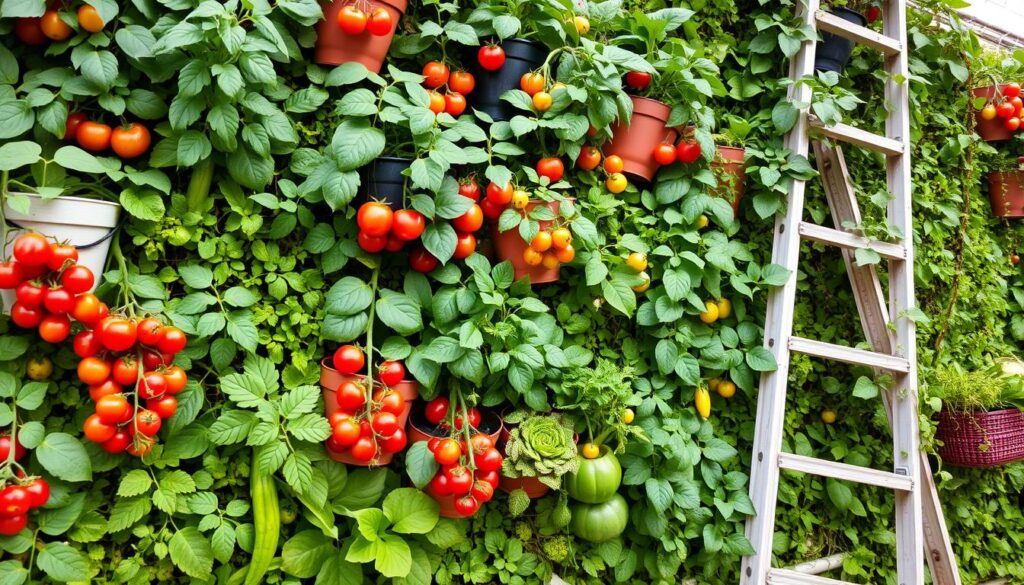
“The secret to growing a thriving garden in a small space is to think vertically. Trellises, wall-mounted planters, and hanging baskets can transform your container garden into a lush, space-saving oasis.”
Pest and Disease Management
Container gardens have many benefits but can face pests and diseases. By using proactive strategies, you can keep your plants healthy. It’s important to check your plants often for pests or diseases. Then, act quickly and organically to fix any problems.
To stop container garden pests, create a diverse garden ecosystem. Add beneficial insects like ladybugs and lacewings that eat garden pests. Use organic pest control methods, such as neem oil or insecticidal soap, to fight pests safely.
To manage container garden diseases, take steps ahead of time. Make sure your containers drain well, choose disease-resistant plants, and clean up any sick or damaged leaves. Disease prevention is crucial, as it’s easier to stop a disease early.
“Vigilance and a multi-pronged approach are the keys to keeping your container garden pest- and disease-free.”
By being proactive and using eco-friendly solutions, you can have a thriving container garden all season.
| Common Container Garden Pests | Organic Control Methods |
|---|---|
| Aphids | Insecticidal soap, neem oil, ladybugs |
| Spider Mites | Neem oil, strong water spray, predatory mites |
| Whiteflies | Insecticidal soap, yellow sticky traps, beneficial insects |
| Slugs and Snails | Diatomaceous earth, beer traps, hand-picking |
Harvesting and Maintenance Tips
Keeping your container-grown vegetables in top shape is key for a great harvest. Follow these tips to make sure your garden stays healthy and gives you lots of fresh, tasty produce.
Harvesting at the Right Time
Harvesting your vegetables when they are at their best is crucial. Look for signs like color, size, and texture to know when they’re ready. Check your plants often and pick them as soon as they’re ready for the best flavor and nutrition.
Maintaining Container Gardens
Keeping your container garden healthy and productive requires regular care. Tasks like pruning, deadheading, and repotting help your plants grow well. Watch for pests or diseases and deal with them quickly to stop problems from getting worse.
| Maintenance Task | Frequency | Benefits |
|---|---|---|
| Pruning | Every 2-3 weeks | Encourages bushy growth and prevents overcrowding |
| Deadheading | As needed | Promotes continuous flowering and prevents self-seeding |
| Repotting | Annually or as needed | Provides fresh, nutrient-rich soil for optimal growth |
By using these container garden harvesting and container garden maintenance tips, you’ll get a lot from your container gardening efforts.

Container Vegetables for Different Seasons
Container gardening lets you grow food all year. By knowing what cool-season and warm-season crops need, you can grow more food. This way, you get food from your garden all year.
Cool-season Crops
When it gets cooler in spring and fall, cool-season veggies do well. These include lettuce, spinach, kale, radishes, and more. They grow well in cooler weather and give you fresh, healthy food.
You can grow these in small spaces with the right plants. This way, you get lots of food even with little space.
Warm-season Crops
When it gets hot in summer, switch to warm-season veggies. These include tomatoes, peppers, zucchini, and eggplants. They love the heat and give you lots of tasty food.
By picking the right plants, your garden will look great and produce a lot. You can grow these in small spaces like patios or balconies.
Learning about seasonal gardening lets you enjoy food all year, even with a small garden. With good planning and care, your garden will be full of different vegetables all season.
| Cool-season Container Vegetables | Warm-season Container Vegetables |
|---|---|
|
|
“Embracing the diversity of container gardening allows you to enjoy a bountiful harvest throughout the year.”
Decorative Container Gardens
Your container garden doesn’t have to be just for growing food. You can mix edible plants with flowers or leaves for a beautiful look. This way, you get to enjoy both the beauty and the harvest of your garden.
Mixing Edibles with Ornamentals
Adding plants that are just for looks can make your garden more interesting. Try pairing leafy greens with nasturtiums or marigolds. These plants come in different shapes and colors, making your garden stand out.
It’s not just about how it looks. Mixing plants can also help keep pests away from your food. For example, marigolds can protect your vegetables. By combining practical and beautiful plants, you make your garden better in many ways.
FAQ
What are the benefits of growing vegetables in containers?
Growing veggies in containers has many perks. It helps use space well, lets you control the growing conditions, and cuts down on weeds and pests compared to traditional gardens.
What factors should I consider when choosing a location for my container garden?
Look for a spot that gets 6–8 hours of sunlight a day for your container garden. It should also be easy to reach and have the right conditions for your veggies to grow well.
What types of containers are best for growing vegetables?
Choose containers made of plastic, ceramic, or wood that drain well. Don’t use garden soil as it can compact and block drainage. Instead, go for a potting mix made for containers.
What are some good vegetable options for container gardening?
Opt for compact or dwarf varieties of veggies like beans, carrots, lettuce, peppers, radishes, spinach, and tomatoes. Herbs and leafy greens also do great in containers and are perfect for small gardens.
How do I care for my container-grown vegetables?
Container plants need different care than those in the ground. They dry out fast, so you’ll need to water them often, especially when it’s hot. You should also feed them regularly to keep them healthy and productive all season.
How can I maximize my vertical space in a container garden?
Use vertical gardening methods to make the most of your space. Try trellises, cages, and supports for climbing veggies like beans. Wall-mounted planters and hanging baskets can also make your garden look great and use space well.
How do I manage pests and diseases in my container garden?
Keep an eye on your plants for pests and diseases. Use organic or natural methods to control any problems quickly. Taking action early can keep your plants healthy.
What are the key maintenance tasks for a thriving container garden?
Good maintenance is key for a great harvest. Prune, deadhead, and repot your plants as needed. Knowing when and how to harvest your crops will help you get the best flavor and nutrition.
Can I grow a variety of vegetables throughout the year in a container garden?
Yes, you can grow different veggies all year in containers. Plant cool-season crops like lettuce and radishes in spring and fall. Warm-season veggies like tomatoes and peppers do well in the summer.
Can I combine edible plants with ornamental flowers or foliage in my container garden?
Yes! Mixing edible plants with flowers or foliage adds beauty and interest to your garden. This way, you can enjoy the look and the taste of your small-space garden.
Source Links
- Quickstart Guide to Container Vegetable Gardening – https://lovelygreens.com/container-vegetable-gardening/
- Container Gardening Made Easy: A Beginner’s Guide to Growing Plants in Small Spaces – https://swanhose.com/blogs/general-gardening/container-gardening-made-easy-a-beginner-s-guide-to-growing-plants-in-small-spaces?srsltid=AfmBOopV8M8IrqLbZ8p8AqfLU1M25eyODgRaly9tyK_NQYBufNdGKQ_9
- Vegetable Container Gardening for Beginners – https://www.almanac.com/content/container-gardening-vegetables
Budget-Friendly Gardening: How to Create a Thriving Garden on a Tight Budget
Do you dream of a garden full of life but worry about the cost? You can make your outdoor space beautiful without spending a lot. But, how do you start when your budget is small?
Key Takeaways
- Use free resources like seed swaps and local garden centers for cheap plants and materials.
- Pick seeds and plants that are easy to grow and give lots of produce.
- Try saving money with composting, upcycling, and making things yourself.
- Look around your community for gardening groups, discounts, and ways to save.
- Grow plants that cost less but produce a lot to make your garden work harder for you.
Start with Free Resources
Starting a garden on a tight budget can be easier than you think. The sun’s light is free and vital for plants to grow well. You can also start your plants from seeds, which costs less than buying full plants.
Look around your community for free or cheap options. Local farms or community compost programs might give you free gardening resources like compost and manure. These are great budget-friendly gardening tips to make your soil rich. Using these free things, you can make a great garden on a tight budget without spending a lot.
- Utilize the sun’s natural light – a free and essential element for plant growth
- Start plants from seeds to save money compared to buying full-grown plants
- Seek out free or low-cost soil amendments like compost and aged manure from local sources
“Gardening is cheaper than therapy, and you get tomatoes.” – Unknown
By using these free resources, you can make a garden that’s both beautiful and productive without spending a lot. With a bit of creativity and resourcefulness, budget-friendly gardening is definitely possible.
Choose Low-Cost Seeds and Plants
Gardening can be rewarding without costing a lot. Saving money in your garden is easy by using low-cost seeds. Seeds are cheaper than buying plants or seedlings from a nursery. They are a great choice for budget-friendly plants.
Seed Saving
To save even more, try seed saving. Collect and store your own seeds to grow your favorite plants year after year. This way, you won’t need to buy new seeds every year. It’s a simple way to keep gardening costs low while growing from seed.
Many vegetables, herbs, and flowers can be grown from seed. Fast-growing crops like carrots, radishes, and lettuce are easy to start. With practice, you can master seed saving and have a low-cost garden every year.
“Seed saving is a game-changer for budget-conscious gardeners. It allows you to grow your favorite plants for free, year after year.”
Build Raised Beds on a Budget
Gardening fans often choose raised beds for a lush, productive garden. But, the cost can rise fast, especially with cedar or redwood lumber. Luckily, there are ways to make raised garden beds affordable.
Using cinder blocks or galvanized stock tanks is a smart choice for budget-friendly raised beds. These are cheap, strong, and simple to put together. Or, get creative with logs, pallets, or rocks for your DIY raised garden beds.
Another way to cut costs is making your own soil. Compost kitchen scraps and yard waste to create rich soil for your beds. This low-cost gardening solution boosts your plants and reduces waste.
Building raised beds on a budget takes time and effort. But, the benefits are huge. With creativity and hard work, you can have a great garden without spending a lot.
“Gardening is cheaper than therapy, and you get tomatoes.” – Unknown
Utilize Recycled and Upcycled Materials
Creating a garden on a budget means thinking creatively and using recycled materials. Instead of buying new tools and supplies, check out thrift stores, garage sales, or online for secondhand items. You can turn old pantyhose, kitchen tools, and other discarded items into unique garden decor and tools. This approach saves money and adds a special touch to your garden.
Creative Container Gardens
There are more ways to garden than just raised beds. Consider using buckets, barrels, or old sinks as containers. These upcycled gardening containers are budget-friendly and can make your garden stand out. They’re perfect for small spaces or patios, letting you create beautiful gardens without spending a lot.
“Gardening is the art that uses flowers and plants as paint, and the soil and sky as canvas.”
With creativity and a fresh perspective, you can turn your outdoor space into a lush, vibrant, and budget-friendly area. Using recycled materials for gardens and upcycled gardening methods saves money and adds a personal touch to your budget-friendly container gardens.
Budget-friendly gardening
Gardening on a tight budget is possible with creativity and resourcefulness. You can make a garden thrive without spending a lot. Focus on affordable gardening and cost-effective gardening to save money on gardening.
Begin by looking for free resources like seed libraries and online gardening groups. These can give you knowledge and plants at little or no cost. Choose cost-effective plants like seeds that you can save and replant.
Building raised beds is a budget-friendly idea. Use old pallets or repurposed wood to make them. This saves money and adds a personal touch to your garden.
- Explore free resources like seed libraries and plant swaps
- Choose affordable seeds and plants that can be saved and reused
- Construct raised beds using recycled or upcycled materials
- Embrace frugal gardening practices like composting and rainwater harvesting
- Create DIY garden tools and accessories from repurposed items
Using these budget-friendly gardening tips, you can have a great garden without spending a lot. With creativity and starting small, you can make a beautiful, cost-effective garden. It will feed your body and your wallet.
Embrace Frugal Gardening Practices
Creating a garden on a tight budget can be done with frugal gardening practices. Techniques like composting and companion planting help you save money. They also make your garden more productive.
One key to saving money is making your own compost. Use kitchen scraps and yard waste to create nutrient-rich soil. This way, you avoid expensive fertilizers and support healthy plants. Sustainable gardening means being smart with resources and reducing waste.
Another way to save is through companion planting. Choose plants that help each other out. For instance, marigolds can keep aphids away from your veggies. Frugal gardening tips like this make your garden both healthy and affordable.
Attracting helpful insects like bees and ladybugs can also save you money. These insects help control pests and keep your plants healthy. By using these methods, you can have a great garden without spending a lot.
“Gardening is an exercise in patience and optimism. No matter how bad the weather, how poor the soil, or how many bugs, a gardener always believes that next year will be better.” – Rosalie Muller Wright
Frugal gardening is about being clever, patient, and flexible. With these strategies, you can have a beautiful garden on a budget. And you’ll enjoy the rewards for many years.
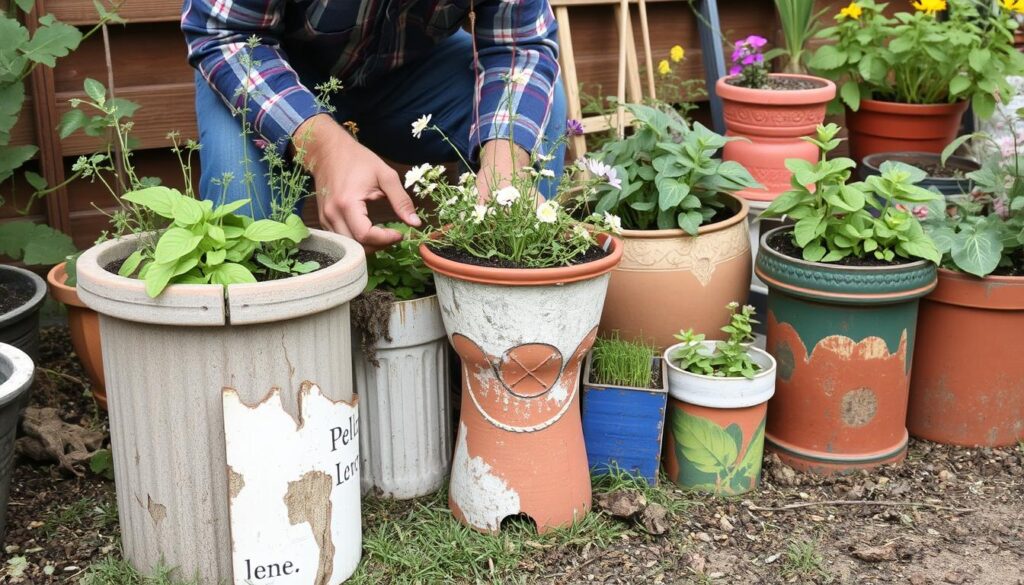
| Frugal Gardening Practice | Benefits |
|---|---|
| Composting | Provides nutrient-rich soil, reduces waste |
| Companion Planting | Naturally deters pests, reduces need for pesticides |
| Attracting Beneficial Insects | Controls garden pests, promotes plant health |
DIY Garden Tools and Accessories
Gardening is a rewarding hobby, but it can get expensive. Luckily, you can make your own tools and accessories without spending a lot. Start by looking for secondhand tools at thrift stores, garage sales, or online. Over time, you can buy better tools that last longer. But starting with cheaper options helps you see which tools you really need for your DIY garden tools.
Upcycled Garden Decor
Make your outdoor space special with upcycled garden decor. Be creative and turn household items into garden decorations. You can use old tin cans as planters or turn windows into garden frames. Upcycling saves money and adds a unique touch to your budget-friendly gardening tools.
- Repurpose glass jars or bottles as unique planters
- Turn old pallets into raised garden beds or vertical plant stands
- Upcycle old tires into vibrant flower planters
- Use reclaimed wood to create custom garden signs or trellises
By making your own tools and decorations, you can garden without spending a lot. Embrace the DIY spirit and show off your creativity with upcycled garden decor that’s all your own.
Swap and Share with Community
Connecting with your local gardening community can be a great way to get plants, seeds, and resources for little to no cost. Look for plant swaps, seed exchanges, or neighborhood plant sales. Here, you can trade your extra seedlings or divisions for new plants. You might also meet gardeners ready to share cuttings, seeds, or advice.
Sharing and exchanging can greatly help in making your garden thrive on a budget. Fostering relationships within your local gardening community lets you get plants, materials, and knowledge without buying everything new.
| Benefit | Description |
|---|---|
| Access to Free or Low-Cost Resources | Join plant swaps, seed exchanges, and community plant sales to get new plants and materials without spending a lot. |
| Knowledge Sharing | Meet experienced gardeners in your area who can give valuable advice and insights to help your garden grow. |
| Fostering Community | Building relationships with other gardeners in your area creates a sense of community and can lead to lasting connections and support. |
By tapping into your local gardening community, you can access a lot of shared gardening resources and expertise. This can help revitalize your garden on a tight budget.
Grow Low-Cost, High-Yield Crops
When you’re on a tight budget, focus on growing crops that give you the most value. Look for high-yielding vegetables, cost-effective crops, and budget-friendly gardening options. These are easy to grow and produce a lot of food.
Some of the most productive and cost-effective crops to consider include:
- Tomatoes: A single tomato plant can yield several pounds of juicy, flavorful fruit.
- Zucchini: This prolific vegetable can provide an impressive number of squash per plant.
- Beans: Both bush and pole beans are simple to grow and can deliver a bountiful harvest.
- Leafy greens: Lettuce, kale, and spinach grow quickly and can be harvested repeatedly.
- Herbs: Fresh herbs like basil, parsley, and thyme add flavor to your meals and are easy to cultivate.
By choosing high-yielding vegetables and cost-effective crops, you can make the most of your gardening efforts. This way, you create a productive, budget-friendly gardening space.
“The key to a successful, budget-friendly garden is to focus on plants that give you the most bang for your buck.”
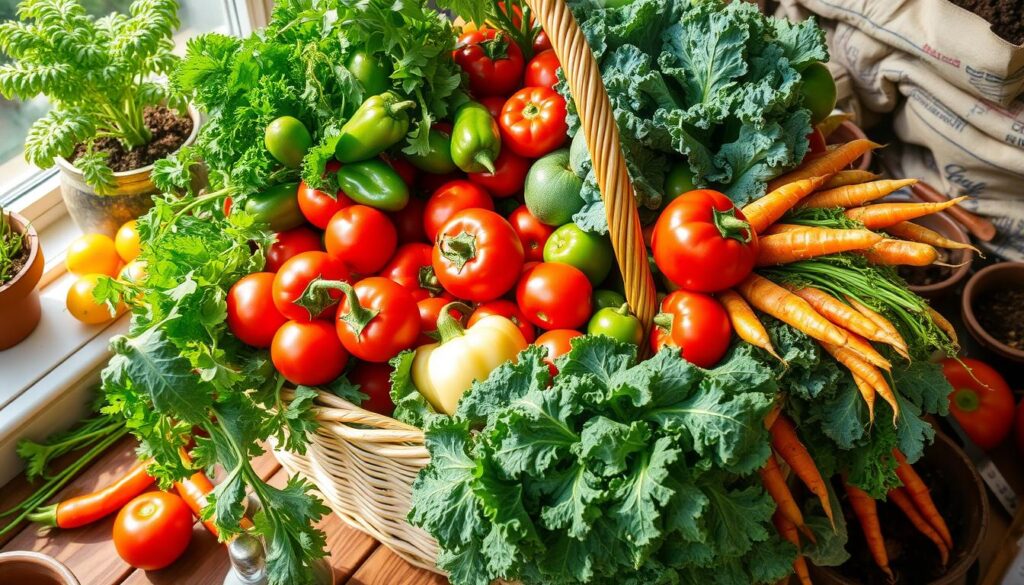
The goal is to grow as much food as possible with minimal investment. With a little planning and the right crop choices, you can enjoy a thriving garden. This garden will nourish your family and help your wallet too.
Preserve and Store Your Harvest
After enjoying your budget-friendly garden, it’s key to keep your harvest safe. Learn how to canning and freezing to enjoy your garden’s preserving garden harvest even when it’s not in season.
Canning and Freezing Techniques
Canning lets you keep fruits, veggies, and herbs in jars, making them last for months. It’s a great way to extend garden bounty and reduce waste. Or, freezing is fast and easy, keeping your garden’s best flavors and nutrients for later.
- Learn water bath canning for things like tomatoes, berries, and pickles.
- Try pressure canning for veggies that aren’t acidic, for safety and long storage.
- Freeze fruits and veggies when they’re ripe for eating all year.
- Check out dehydrating for tasty dried herbs, fruits, and veggies.
| Preservation Method | Pros | Cons |
|---|---|---|
| Canning | – Keeps food safe for a long time – Keeps nutrients and taste – Saves money |
– Needs special tools – Takes a lot of time |
| Freezing | – Keeps food fresh and full of nutrients – Quick to use – Fits easily into recipes |
– Needs freezer space – Can cause freezer burn |
| Dehydrating | – Makes food last longer – Makes flavors stronger – Takes up less space and is easy to store |
– Needs special tools – Can take a lot of time |
Learning these preserving garden harvest methods lets you enjoy your garden’s taste all year. It’s a great way to use your gardening skills wisely.
Seek Out Local Resources and Discounts
Being a budget-conscious gardener can really pay off. Look beyond big-box stores for community gems that save you money. These spots can help you cut down on gardening costs.
Begin by finding plant sales, seed swaps, or gardening classes in your area. Local groups, nonprofits, and extension services often host these events. They offer plants, seeds, and advice at low prices. This makes them perfect for smart gardeners. By using local gardening resources, you can grow a beautiful garden without spending a lot.
Also, talk to local nurseries, home improvement stores, or landscape suppliers. They might give discounts for gardeners who buy in bulk or during special sales. Discounts on soil, mulch, or other budget-friendly gardening supplies can really help you save.
| Local Resource | Potential Savings |
|---|---|
| Plant sales | 50-80% off retail prices |
| Seed swaps | Free or low-cost seeds |
| Gardening classes | Discounted or free admission |
| Bulk purchasing | 10-20% off regular prices |
Using these local resources and discounts can help you have a great garden on a budget. Embrace the community spirit and enjoy your garden without overspending.
Conclusion
Gardening on a tight budget is totally doable with creativity and smart choices. You can use free resources, pick low-cost seeds and plants, and make your own raised beds. This way, you can have a great garden without spending a lot of money. Use budget gardening, cost-effective gardening, and frugal gardening tips to make your outdoor area a lush paradise.
Using recycled materials and community resources can also help save money. By composting, planting together with other plants, and keeping your harvest, you can get more from your garden. Join your local gardening group to find deals and share tips, making your budget gardening even better.
With patience and creative thinking, your cost-effective gardening can grow into a beautiful, self-supporting garden. Follow the frugal gardening tips in this article and start a gardening journey that’s good for your wallet and your spirit.
FAQ
How can I start a garden on a tight budget?
To start a garden on a tight budget, use free resources like sunlight. Choose seeds over fully-grown plants. Use free or low-cost soil amendments like compost and aged manure from local sources.
What are some budget-friendly options for raised garden beds?
For budget-friendly raised garden beds, use materials like cinder blocks, galvanized stock tanks, logs, pallets, or rocks instead of expensive lumber. Making your own compost can also save on soil costs.
How can I incorporate recycled and upcycled materials into my garden?
Find secondhand tools, supplies, and containers for your garden. Use old pantyhose, kitchen utensils, buckets, barrels, and discarded items like sinks. Upcycling adds unique and budget-friendly touches to your garden.
What are some frugal gardening practices I can adopt?
Use sustainable and cost-saving techniques. Make your own compost and use companion planting to naturally deter pests. Attract beneficial insects to reduce the need for costly pesticides.
How can I connect with my local gardening community to save money?
Join plant swaps, seed exchanges, or neighborhood plant sales to trade your extra seedlings or divisions for new plants. Connect with experienced gardeners for plants, materials, and knowledge at little to no cost.
What are some low-cost, high-yielding crops I should focus on growing?
Grow vegetables, herbs, and fruits that are easy to grow and yield a lot, like tomatoes, zucchini, beans, leafy greens, and herbs. These crops provide abundant harvests and save money on groceries.
How can I preserve and store my garden’s bounty to extend its benefits?
Use canning, freezing, and drying to save money by enjoying your garden’s harvest all year. Canning preserves produce in jars for shelf-stable storage. Freezing is great for preserving fresh fruits and vegetables quickly.
Where can I find local resources and discounts to save money on gardening supplies?
Look for plant sales, seed swaps, or gardening classes from community organizations, nonprofits, or cooperative extension services. These events offer plants, seeds, and advice at low prices. Check with local nurseries, home improvement stores, or landscape supply companies for bulk pricing or discounts.
Source Links
- How to Start a Garden on a Budget – https://www.tenthacrefarm.com/how-to-start-a-garden-on-a-budget/
- Simple Gardening on a Tight Budget – https://thehumbledhomemaker.com/simple-gardening-tight-budget/
- Dirt Cheap: 12 Easy Ways to Garden on a Budget – https://zerowastehomestead.com/dirt-cheap-12-easy-ways-to-garden-on-a-budget/
- 10 Must-Have Blooms for Your 2025 Garden
- The Health Advantages of Gardening You Need to Know
- How to Create a Small Vegetable Garden Layout Plan: A Beginner’s Guide
- DIY Garden Projects for Small Spaces: Upcycling Ideas to Maximize Your Garden
- Watering Techniques for Small Gardens: Ensuring Your Plants Thrive
- Small Border Plants for Landscaping: Adding Beauty and Functionality to Your Garden
- Year-Round Small Space Gardening: Seasonal Planting Tips for Maximum Harvest
- Essential Tools for Small-Space Gardening: What You Really Need
- The Ultimate Guide to Container Vegetables: What to Grow in Small Spaces
- Budget-Friendly Gardening: How to Create a Thriving Garden on a Tight Budget
- How to Optimize Sunlight in Small Gardens: Tips for Better Plant Growth
- DIY Vertical Planters: Creative Ideas for Small Space Gardening
- Companion Planting for Small Vegetable Gardens: Boost Growth and Deter Pests
- Container Gardening Essentials: Choosing the Right Pots, Soil, and Plants
- Vertical Gardening Techniques: Maximizing Your Small Space with Climbers and Vines
- How to Build a Raised Bed Garden in a Small Backyard: Step-by-Step Guide
- The Best Vegetables for Small-Space Gardens: High-Yield Varieties You Need to Grow
- Smart Vegetable Garden Layouts for Small Spaces: Maximizing Your Green Thumb in Compact Areas
- 40. Best Practices for Managing a Sustainable Garden Year-Round
- Building a Wildlife Pond for Biodiversity
- Advanced Techniques in Sustainable Gardening
- How to Create a No-Till Garden
- The Mental Health Benefits of Gardening
- Using Technology to Enhance Sustainable Gardening
- Getting Certified Organic: Steps and Benefits
